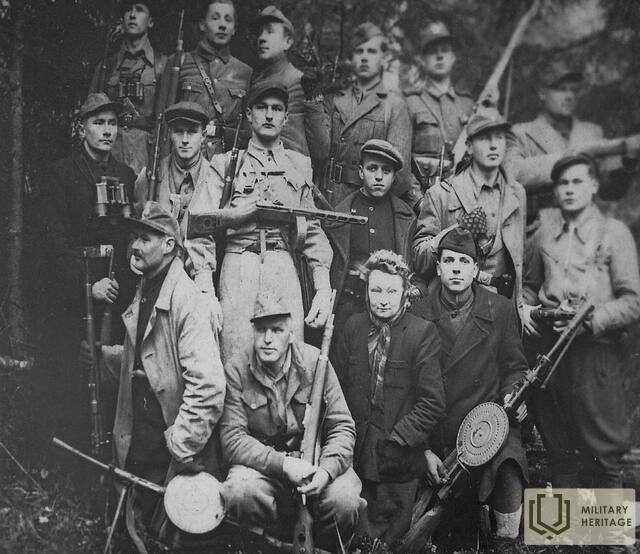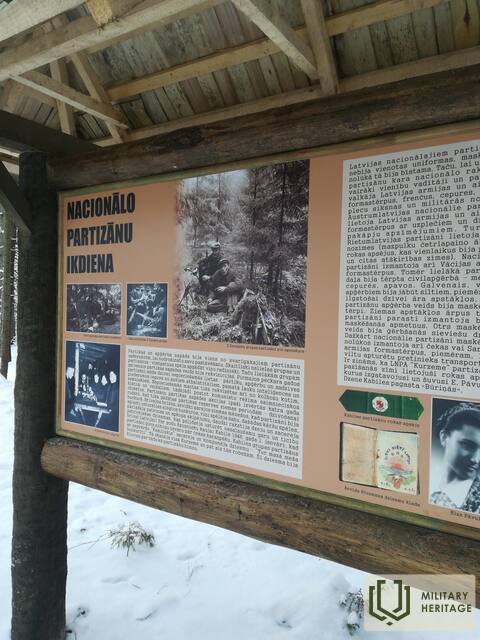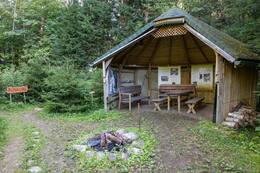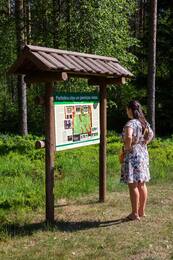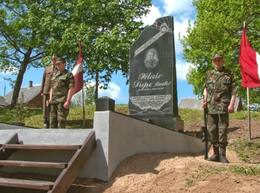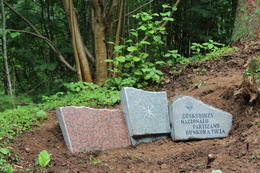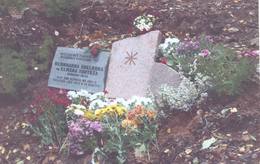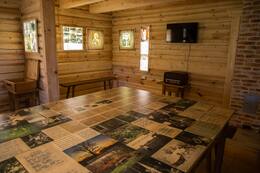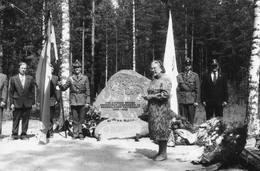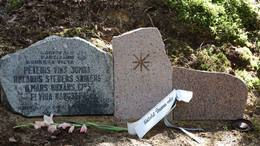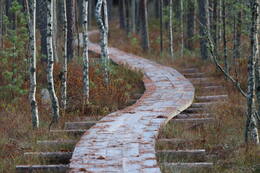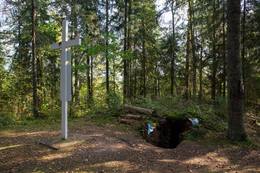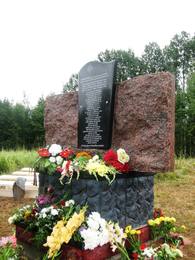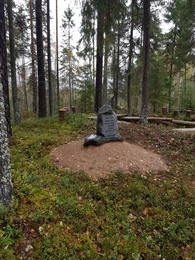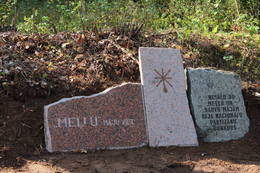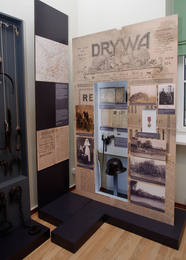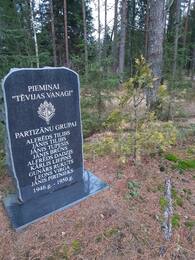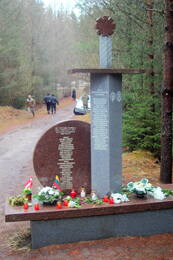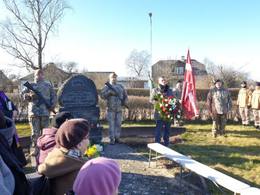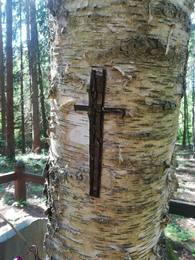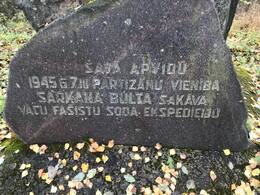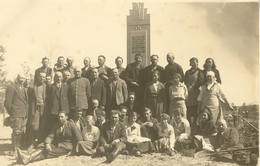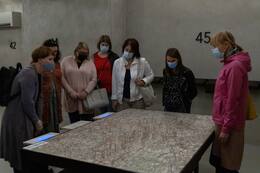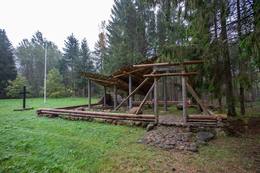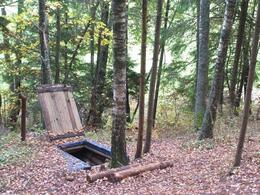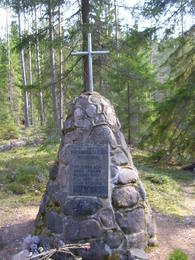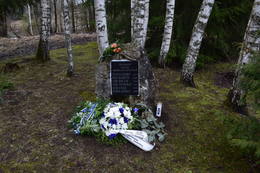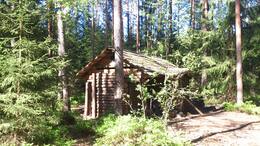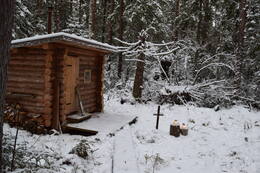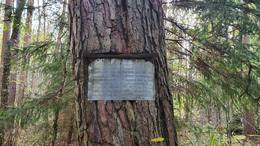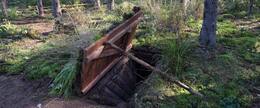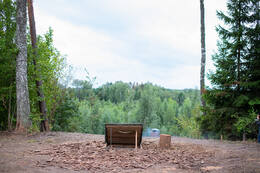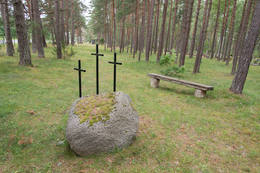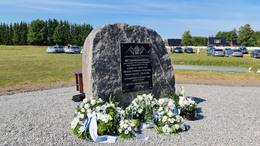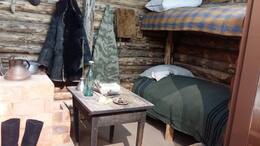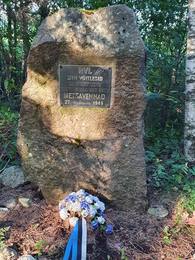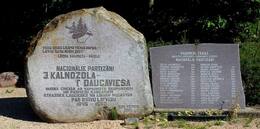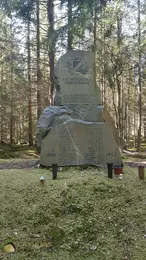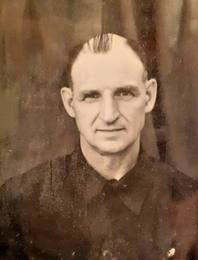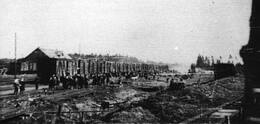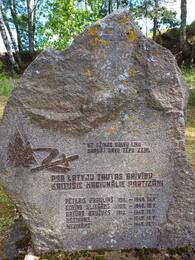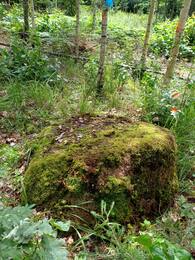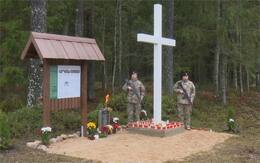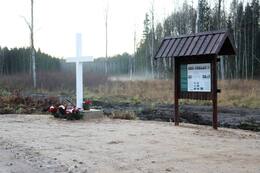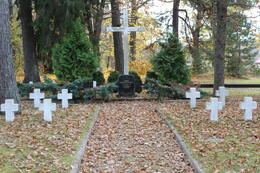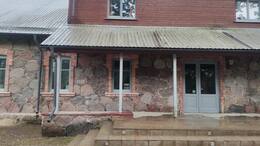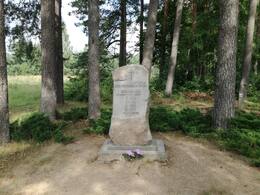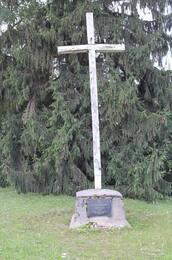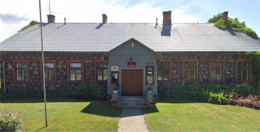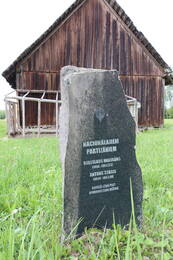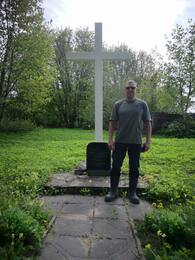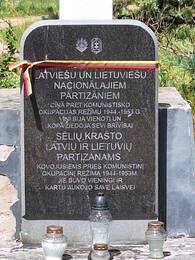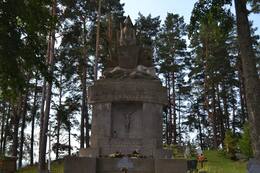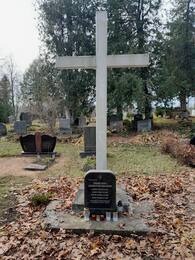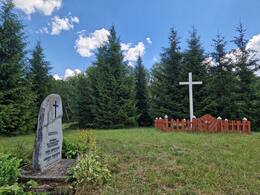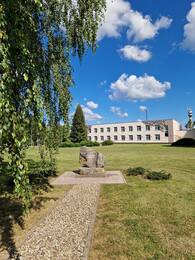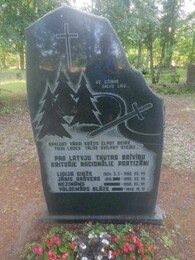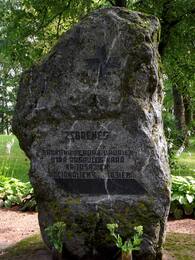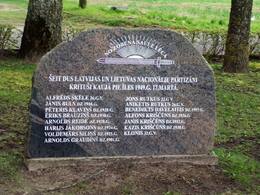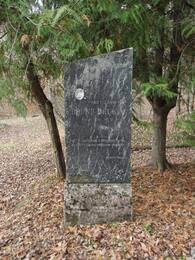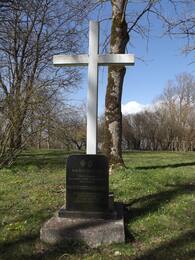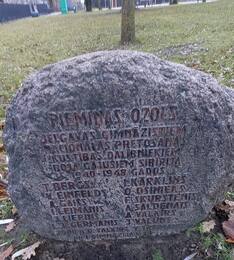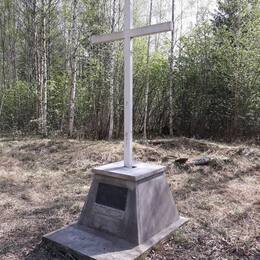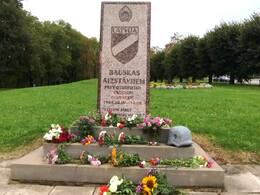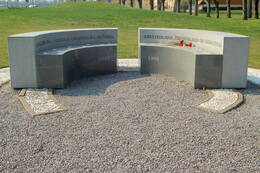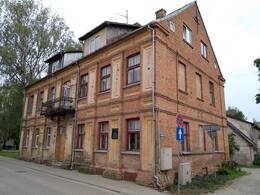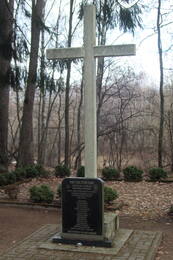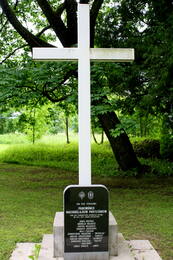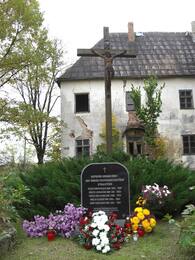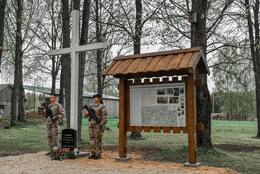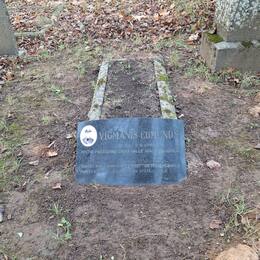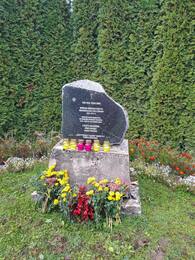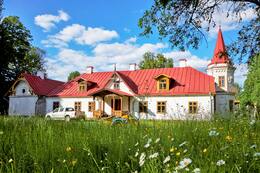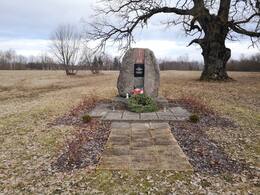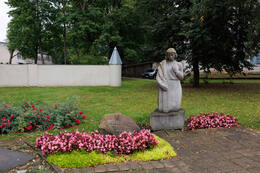Nacionaliniai partizanai / Miško broliai
II Antrasis pasaulinis karas, III Nacionaliniai partizanai
Nacionaliniai partizanai arba miško broliai buvo nedidelės, ginkluotos vietos gyventojų grupuotės, kurios nuo 1944 iki 1956 metų savarankiškai kovojo prieš SSRS okupacinį režimą Latvijos teritorijoje.
Priversti slėptis miškuose, tai buvo žmonės, kurie negalėjo arba nenorėjo gyventi Sovietų Sąjungoje. Tai buvo Latvijos gyventojai, nuo 1944 m. rugpjūčio iki 1957 m. gegužės ginkluota kova ir partizaniniu karu kovoję su SSRS okupaciniu režimu.
Partizanų kovos su okupacinių režimų pajėgomis vyko nuo 1944 m. vasaros pabaigos.
Iš viso Latvijoje buvo apie 20 193 miško broliai / nacionaliniai partizanai.
Daugiau informacijos šaltinių
Latvijos nacionalinių partizanų kovos – Nacionalinė enciklopedija (enciklopedija.lv)
Susijusi laiko juosta
Susijusios vietos
Nacionalinių partizanų bunkeris – Miško broliai
Miško brolių bunkeris yra prie Rygos–Pskovo (A2) greitkelio, 76 kilometrus nuo Rygos ir 11 kilometrų nuo Cėsių. Latvijos nacionaliniai partizanai arba miško broliai buvo nedidelės, ginkluotos vietos gyventojų grupuotės, kurios nuo 1944 iki 1956 metų Latvijos teritorijoje kovojo savarankiškai prieš SSRS okupacinį režimą. Miškuose buvo priversti slėptis žmonės, kurie negalėjo arba nenorėjo gyventi Sovietų Sąjungoje. Iš viso Latvijoje veikė apie 20 193 miško broliai. Bunkeris buvo suformuotas remiantis buvusių miško brolių pasakojimais ir prisiminimais apie gyvenimą miškuose, slapstymąsi ir kovą už nepriklausomą Latvijos valstybę po 1945 metų. Bunkeryje eksponuojami ginkluotė ir namų apyvokos daiktai. Eksponuojami partizanų asmeniniai daiktai, ginklai ir nuotraukos. Gido pasakojimą papildo vaizdo įrašas iš interviu su miško broliais. Prie bunkerio yra vieta piknikui. Galima iš anksto užsisakyti ant laužo paruoštos sriubos arba mėgautis vakaru po atviru dangumi žiūrimu kino teatru prie laužo.
Gryvos miške vykusios nacionalinės ir sovietinės partizanų kovos ir atminimo vietos
Įsikūręs Gryvos miškų masyve.
Galima apžiūrėti šešis objektus, susijusius su nacionalinių ir sovietinių partizaninių kovų vietomis.
Gryvos miško masyve yra ne tik „Purvsalinių“ nacionalinių partizanų štabas, Baltasis kryžius nacionalinių partizanų bunkeryje ir kryžius pasipriešinimo judėjimo vadui Andrejui Roskošui, bet ir sovietinės partizanų brigados vado Artūro Baložo kapas, paminklas vadinamojoje Meitenių kalninėje, kur 1944 m. žuvo grupė jaunų sovietinės partizanų brigados partizanų, taip pat sovietinių partizanų paminklas su penkiakampe žvaigžde ir išgraviruotais žodžiais „Mes apsigaubėme savo adatomis“.
Objektus taip pat galima apžiūrėti važiuojant dviračiu 785 dviračių maršrutu „Istoriniai eilėraščiai Gryvos miškuose“ (maršruto ilgis 34 km, žvyrkeliai ir miško keliai). Žemėlapį galima atsisiųsti.
Nacionalinio partizanų būrio vado Andrejaus Roskošo atminimo paminklas (GPS 56.87399, 27.43524)
1997 m. rudenį Lielgryvos miške buvo atidengtas Baltasis kryžius nacionalinių partizanų grupės vadui Andrejui Roskošui.
Paminklas Artūrui Balodiui (GPS 56.872926, 27.478121)
Artūras Balodis buvo sovietų partizanas, A dalinio, dislokuoto Gryvos miško masyve, specialiųjų operacijų vadas. Jis žuvo per didelio masto „šukavimą“, kurį vykdė nacistinės Vokietijos okupantai. Jo bendražygiai žuvimo vietoje berže išraižė raides AB, kad jis nepamirštų. Po karo vietos istorikai rado pažymėtą beržą ir jo vietoje įrengė atminimo lentą.
Visiems žuvusiems Gryvos miškuose (GPS 56.863280, 27.47975)
Šį atminimo akmenį Gryvos miško masyve įrengė valstybės įmonė „Latvijas valsts meži“ pagerbiant partizanus, kovojusius už savo tėvynę. Šalia atminimo akmens yra žemėlapis-schema su partizanų štabų – lankytinų objektų nuorodomis. Taip pat įrengta poilsio zona. Netoliese yra nacionalinių partizanų gyvenvietės vieta, 1945–1947 m.
Nacionalinių partizanų gyvenvietė (GPS 56.863456, 27.481148)
Šioje vietoje buvo įsikūrusios nacionalinių partizanų, kovojusių su sovietų okupacija, gyvenvietės. Išliko atskirų bunkerių vietos, iš kurių vizualinės išvaizdos galima spręsti, kokio dydžio ir kokios formos buvo apkasai. Gryvos miškuose dar keletą metų po Antrojo pasaulinio karo veikė nacionaliniai partizanai, priešinęsi sovietų valdžiai.
Mergaičių kalnelis (GPS 56.858187, 27.521526)
1944 m. birželį nacistinės Vokietijos okupantai surengė didelio masto Gryvos miškų „šukavimą“, siekdami sunaikinti partizanus. Kareiviai apsupo Numernės kalno ūkio įmonę, kurią daugiausia sudarė jaunos merginos, ir visos buvo sušaudytos. Po šių tragiškų įvykių vietos gyventojai Numernės kalną pervadino Meitenių kalnu. Šioje vietoje pastatytas atminimo akmuo.
Paminklas Šiaurės Rytų nacionalinių partizanų vadui Pēteriui Supei – „Cinītis“
Pagerbiant nacionalinių partizanų vado Pēterio Supės atminimą, 2005 m. gegužės 28 d. Viliake buvo atidengtas jam skirtas paminklas. Jis stovi netoli Viliakos katalikų bažnyčios, karo metu iškastų apkasų pakraštyje, kur čekistai laidojo sušaudytus nacionalinius partizanus. Po P. Supės paminklu įdėta kapsulė su 386 žuvusių nacionalinių partizanų vardais, mūšių aprašymais ir medžiaga apie partizanų vadą. Akmenyje iškalti žodžiai: „Tau, Latvija, likau ištikimas iki paskutinio atodūsio“.
Paminklą suprojektavo Pēteris Kravalis.
Netoliese yra memorialas Latvijos laisvės kovotojams, žuvusiems Stompaku miške ir kitose mūšių vietose bei nužudytiems čekistų 1944–1956 m.
2008 m. birželio 20 d. dešinėje sienoje buvo atidengta granito lenta su trimis stulpeliais išdėstytais 55 žuvusių partizanų vardais.
Paminklas pastatytas toje vietoje, kur komunistinė okupacinė valdžia kadaise eksponavo nužudytų partizanų palaikus, siekdama įbauginti likusius gyventojus.
Ant greta esančios lentelės išgraviruoti padėkos žodžiai Pēteriui Supei ir Bronislavos Martuževos eilėraštis:
"Kelkis, Piteri Supe,
Siela, kovok kare!
Šiandien tavo kraujo auka,
Iškilo tarp žmonių.
Išeik ir gyvenk amžinai
Jaunystės stiprybėje ir energingoje
Jis plasnoja, plasnoja, plasnoja
"Kylančioje vėliavoje!"
Nacionalinių partizanų atminimo vieta Sērmūkšyje
Sērmūkšuose yra vienas iš daugiau nei šimto partizanų kovų memorialų Latvijoje. Latvijoje yra daugiau nei šeši šimtai partizanų kovų vietų. Remiantis istoriniais įrodymais pastatytas Latvijos nacionalinių partizanų žeminė, kurioje lankytojai gali praleisti naktį beveik autentiškomis sąlygomis su medinėmis lovomis, apšvietimu žibalinėmis lempomis ir šildymo prietaisu, panašiu į tuos, kuriuos naudojo partizanai. Apsilankymą būtina užsisakyti iš anksto. Lemtinga akimirka Sērmūkšų nacionalinių partizanų grupei atėjo 1946 m. lapkričio 29 d., kai žuvo keturi grupės kovotojai: Janis Zīrāks, Reinholds Pētersons, Janis Pīlands ir Anna Zariņa. Alfrēdsas Suipe išgyveno, atlaikė tremtį, grįžo į Latviją ir sulaukė laisvos valstybės atkūrimo. Jis inicijavo idėją Sērmūkšuose įsteigti memorialinę vietą savo žuvusiems bendražygiams.
Alsvikių parapijos nacionaliniams partizanams skirtas atminimo akmuo „Čūskubirzyje“
Įsikūręs „Čūskubirž“, Alsvikių valsčiuje, Alūksnės savivaldybėje.
Atminimo akmuo atidengtas 2018 m. rugpjūčio 21 d. Akmenkalis Ainārs Zelčs.
Čia, miško masyve, išlikusi bunkerio vieta, kur 1947 m. birželį Latvijos nacionalinių partizanų asociacijos Generalinio štabo ryšių skyriaus viršininkas Antonas Circanas atvyko į susitikimą su Bruno Bukalderso vadovaujamais partizanų atstovais, siekdamas organizuoti ir palaikyti ryšius tarp atskirų nacionalinių partizanų grupių. Antono Circano tikslas nebuvo įgyvendintas, nes jis žuvo 1947 m. liepos 7 d. netoli Drustų.
Atminimo lenta Veclaicenės nacionaliniams partizanams bunkerio vietoje
Įsikūręs Veclaicenės valsčiuje, Alūksnės rajone.
Atidaryta 2019 m. spalio 4 d. Akmenkalis Ainārs Zelčs.
1953 m. kovo 13 d. Veclaicenės miškuose, netoli „Korulių“ namų, čekistai aptiko kruopščiai užmaskuotą bunkerį ir suėmė Bernhardą Ābelkoką ir Elmārą Tortūzą.
Bunkeryje buvo rasti ginklai: 2 vokiški šautuvai ir 95 šoviniai, 2 „Parabellum“ pistoletai ir 152 šoviniai.
1949 m. lapkričio 11 d. Čekos agentai sušaudė K. Dokti-Dokteniekus, o jo grupuotė iširo. Po išpuolio B. Ābelkoksas ir E. Tortūzis kurį laiką slapstėsi bunkeryje netoli „Maskalių“ namų, tačiau nuo 1951 m. pavasario, padedami Ilonos Ābolkalnos, įsikūrė bunkerį „Koruliuose“, kur gyveno iki suėmimo.
Bronislavos Martuževos poezijos klėtelė
Bronislavos Martuževos muziejus įsikūręs poetės vaikystės namų vietoje Indranų valsčiuje, Maduonos savivaldybėje. Muziejaus ekspozicija įrengta renovuotame tvarte, kuriame eksponuojami balso ir vaizdo įrašai iš Nacionalinio pasipriešinimo judėjimo, poetės darbo leidžiant pogrindinį žurnalą, taip pat kuriant eilėraščius ir dainas nacionaliniams partizanams. Bronislava Martuževa dalyvavo pasipriešinimo judėjime nuo pat jo įkūrimo. Lazdinės, Martuževos namai, kurie neišliko, taip pat buvo prieglobstis Latvijos nacionalinių partizanų asociacijos vadovui Pēteriui Supei ir jo bendražygiams. Poetė penkerius metus slapstėsi savo namų rūsyje, susitikinėjo su partizanais, rašė eilėraščius (įskaitant kūrinius, skirtus partizanams Pēteriui Supei, Viliui Tomui, Smilgos grupei, Laiveniekui, Salnui, Celmiņui, Bruno Dundurui ir kitiems), taip pat rašė dainas ir mokė jų partizanus. Dabar jos dainas dainuoja grupė „Baltie lāči“ (pažodžiui: „Baltieji lokiai“). 1950 m. kartu su Viliu Tomu pogrindyje buvo leidžiamas žurnalas „Dzimtene“ (pažodžiui: „Tėvynė“). Poetas ranka perrašė 11 žurnalo numerių, po 10 egzempliorių. Poetė, jos brolis, sesuo, motina ir Vilis Tomas buvo suimti 1951 m. Bronislava Martuževa iš Sibiro grįžo 1956 m. Pripažintas vietos ir šalies mastu, poezijos tvartą lanko tiek vietos gyventojai, tiek savivaldybės svečiai. Susipažinimas su poetės gyvenimu suteikia galimybę atrasti Latvijos likimą.
Paminklas žuvusiems Latvijos legiono kariams ir nacionaliniams partizanams
Įsikūręs Lubanos naujosiose kapinėse Indrani parapijoje.
Apžiūrėti galima žuvusių Latvijos legiono karių ir nacionalinių partizanų atminimo vietą.
Memorialas atidengtas 1992 m. liepos 25 d. Atminimo akmenį sukūrė Andris Briezis.
Prasidėjus Atbudimui, 1990 m. spalį žmogaus teisių grupės „Helsinkis 86“ narys Kārlis Doropolskis gavo valdžios leidimą pradėti perlaidoti 1944 m. vasarą Lubanoje žuvusius ir palaidotus Latvijos legionierius, taip pat vėlesniuose mūšiuose su sovietų okupacine kariuomene ir saugumo institucijomis žuvusius nacionalinius partizanus bendruose masiniuose kapuose, kurie buvo įrengti naujose Lubanos kapinėse. Iš viso masiniuose kapuose buvo palaidoti 26 žuvę legionieriai ir nacionaliniai partizanai.
Nacionalinės partizanų grupės „Jumba“ bunkerio atminimo vieta
Įsikūręs Ziemerso parapijoje, Valstybinio miško 66-ajame kvartale.
Memorialas buvo atidengtas 2020 m. liepos 10 d.
Antrajame Latvijos nacionalinio partizanų judėjimo etape, 1948 m. viduryje, nuo J. Bitāno-Liepačo būrio Mālupē-Bėjos valsčių teritorijoje atsiskyrė 4 asmenų grupė - Vikas Pētersis, Steberas Rolandas, Bukanas Ilgmārs ir Kangsepa Elvīra, kurie pradėjo savarankišką veiklą Ziemeros-Jaunlaicenės-Veclaicenės valsčiuose. Partizanų štabas buvo netoli Estijos sienos, netoli Rygos-Pskovo plento, ant kalvos, gerai įrengtame bunkeryje.
1950 m. kovo 2 d., čekistams aptikus bunkerį, partizanai pasislėpė iš riedulių pastatytame tvarte „Napke“ name Estijos pusėje. Po ilgų ir įnirtingų susišaudymų 1950 m. kovo 3 d. čekistams pavyko tvartą padegti. Ilgmārs Bukāns, Rolands Stebers ir Elvīra Kangsepa sudegė kartu su naujagime dukra. Pēteris Viks iššoko pro tvarto langą ir pasislėpė namo palėpėje, kur buvo rastas ir sušaudytas. Ūkis buvo sudegintas. Visų žuvusių partizanų kūnai buvo išvežti į Alūksnę. Kovotojų žūties vietoje 1990-ųjų pradžioje buvo pastatytas atminimo ženklas. Elvyros Kangsepos dukra, gimusi degančiame tvarte, buvo vardu Liesma.
Nacionalinių partizanų būstinė gamtos draustinyje „Stompakų pelkės“ (Stompaku purvi)
Antrojo pasaulinio karo metais Stompakų pelkėje buvo viena didžiausių nacionalinių partizanų būstinių Baltijos šalyse. Šiandien ši teritorija priklauso Stompakų gamtos draustiniui. Pelkių salose esančią gyvenvietę galima pasiekti pažymėtu pėsčiųjų taku.
1945 m. pradžioje Stompakų pelkėje buvusioje nacionalinių partizanų būstinėje gyveno 350–360 žmonių, iš jų – 40 50 moterų. Joje buvo 24 gyvenamieji bunkeriai – pusiau į žemę įkasti statiniai, kuriuose galėjo gyventi 3–8 žmonės. Būstinėje taip pat veikė kepykla, požeminė bažnyčia ir trys antžeminės pašiūrės arkliams. Partizanai rengė išpuolius prieš okupacinio režimo pareigūnus.
1945 m. kovo 2–3 d. čia vyko Stompakų mūšis – didžiausias nacionalinių partizanų susirėmimas Latvijoje. Būstinėje buvusius 350–360 partizanų puolė NKVD 143-asis šaulių pulkas ir vietinio stribų (rus. „isterbiteli“) bataliono kovotojai – iš viso 483 vyrai. Mūšis truko visą kovo 2 dieną. Kovo 3-iosios naktį partizanams pavyko ištrūkti iš būstinės ir pasitraukti į ankstesnės bazės vietą. Mūšyje žuvo 28 partizanai, o NKVD neteko 32 karių.
Šiuo metu Stompakų būstinės vietoje yra atkurti trys bunkeriai – bažnyčia, štabas ir gyvenamasis bunkeris, taip pat 21 bunkerio vieta. Įrengti informaciniai stendai apie būstinę ir mūšį. Galima užsisakyti ekskursijas su gidu.
Vesetos partizanų žeminė ir atminimo vieta „Baltasis kryžius“ (Baltais krusts)
Vesetos partizanų žeminė ir atminimo vieta „Baltasis kryžius“ yra Vesetos užliejamos pelkės teritorijoje.
Po Antrojo pasaulinio karo Vietalvoje veikė vadinamoji Parupo partizanų grupė. Jai vadovavo Richardas Parupas (1914–1946), buvęs vokiečių kariuomenės 15-osios latvių divizijos seržantas. Karo metais jis dalyvavo nacionalinių partizanų veikloje Jėkabpilio ir Maduonos apylinkėse. Per neilgą gyvavimo laikotarpį Parupo grupė surengė daugiau kaip dvidešimt ginkluotų susirėmimų su tuometės Vidaus reikalų ministerijos daliniais.
Čekistų pulkininko Kotovo ataskaitoje savo vadovybei Rygoje teigiama, kad dėl šios grupės veiklos sovietinės valdžios įsitvirtinimas Jekabpilio ir Maduonos rajonuose buvo paralyžiuotas. Parupo vadovaujami nacionaliniai partizanai surado ir sunaikino kelis tremiamųjų sąrašus, taip išgelbėdami daugelio žmonių gyvybes. Kadangi atviroje kovoje nacionalinių partizanų būrio sunaikinti nepavyko, Saugumo komitetas į jį infiltravo keturis čekistų specialiosios grupės narius. 1946 m. liepos 2 d. naktį šie agentai nušovė dešimt būrio partizanų, tarp jų ir Richardą Parupą.
Nužudytųjų palaidojimo vieta nežinoma, tačiau Rygos brolių kapinėse įrengta jiems skirta atminimo lenta. Prie Vesetos partizanų žeminės stovi paminklas „Baltasis kryžius“ – 3 m aukščio baltas kryžius su lenta, kurioje iškalti 1946 m. liepos 2 d. žuvusių partizanų vardai ir pavardės.
Paminklas pasipriešinimo judėjimo dalyviams Stompakyje
Įsikūręs 15 km nuo Balvių, Viljakos kryptimi, dešinėje kelio pusėje.
Matomas atminimo ženklas.
2011 m. rugpjūčio 11 d., minint Latvijos laisvės kovotojų atminimo dieną, Balvu–Viliako plento pakraštyje priešais Stompakų pelkę buvo atidengtas pasipriešinimo judėjimo dalyvių memorialas, skirtas Pēterio Supės tautinių partizanų, žuvusių 1945 m. kovo 2 ir 3 d. mūšiuose, atminimui. Liepos pabaigoje į paminklo pamatus buvo įkasta kapsulė su žinia ateities kartoms. Kapsulėje įdėtas dokumentas su 28 tautinių partizanų, žuvusių 1945 m. kovo 2 ir 3 d. mūšiuose, vardais ir pavardėmis.
„1945 m. vasarį Stompakų pelkės salose, kurias žmonės pradėjo vadinti Stompakų pelkės salelėmis, 2 km nuo Balvų–Viliakos plento, buvo įkurta didžiausia Latvijoje nacionalinė partizanų stovykla, kurioje 22 apkasuose gyveno 360 žmonių. Tarp jų buvo ir legionierių, kurie, legiono divizijai atsitraukiant, su visais ginklais buvo pasilikę tėvo namuose. Siekdami sunaikinti partizanus, 1945 m. kovo 2 d. dviejų Čekos batalionų kareiviai kartu su naikintojais, kurių ginkluotėje taip pat buvo keturi minosvaidžiai, puolė apkasus. Kovos tęsėsi visą dieną, partizanai atkakliai priešinosi, o puolėjai patyrė didelių nuostolių, todėl negalėjo užimti stovyklos ir sunaikinti partizanų. Mūšyje žuvo arba nuo sunkių sužalojimų mirė ir 28 Stompakų pelkės gyventojai. Kitą naktį partizanai mūšiu „praėjo apgultis ir liko nenugalėtas“ prasiveržė pro stovyklas – taip rašė Zigfrīds.“ Apdovanojimų skyriaus Nacionalinio pasipriešinimo judėjimo dalyvių reikalų komisijos pirmininkas Berkis rašo apie Stompako mūšį.
Privati ekspozicija „Abrenės kambariai“ (Abrenes istabas)
Privati ekspozicija „Abrenės kambariai“ įsikūrusi Viliakos mieste, istoriniame pastate. Iš pradžių šis pastatas stovėjo senosios Marienhauzeno turgaus aikštėje. Vėliau čia veikė butai, biurai, įvairios parduotuvės, o Antrojo pasaulinio karo metais – latvių savigynos štabas, gestapas ir čekistų būstinė. Ekspozicijose pristatomi įvairūs Viliakos ir jos apylinkių istorijos laikotarpiai bei įvykiai nuo 1920 iki 1960 metų – kai miestelis priklausė Jaunlatgalės, vėliau Abrenės apskričiai. Tarp eksponatų – Stompakų pelkės partizanų štabo daiktai, pasakojantys apie nacionalinį pasipriešinimą Latgaloje, taip pat dokumentai ir fotografijos iš Nepriklausomybės kovų laikotarpio. Naujausioje ekspozicijoje lankytojai gali susipažinti su kadaise garsia motokroso trasa „Baltasis briedis“
Atminimo vieta „Bitanos bunkeriai“
Įsikūręs Mālupės valsčiuje, Alūksnės sav.
Atminimo akmuo atidengtas 2017 m. spalio 13 d. Akmenkalis Ainārs Zelčs.
1945 m. rugpjūčio 24 d. Latgaloje, Dubnos miškuose, buvo įkurta Latvijos nacionalinė partizanų asociacija (LNPA), kurios tikslas buvo atkurti 1918 m. Latvijos Respubliką. Siekiant geriau koordinuoti partizanų grupių veiklą, buvo įsteigti regioniniai štabai. Bejos, Mālupės ir Mārkalnės valsčiuose veikusios nacionalinės partizanų grupės susijungė į „Priedolainės“ sektorių. Regioniniam štabui vadovavo Janis Liepacis. Kiekviename regioniniame štabe buvo įsteigti propagandos skyriai. Vienas iš jų, vadovaujamas Janio Bitāna, buvo įkurtas Mālupės valsčiaus miškų masyve. Čia, bunkeryje, nuo 1946 iki 1948 m. buvo spausdinami penki Latvijos nacionalinės partizanų asociacijos spaudos leidiniai: „Mazais Latvis“, „Liesma“, „Auseklis“, „Māras Zeme“ ir „Tautas Sargs“. Alūksnės gimnazijos jaunimo pasipriešinimo judėjimas „Dzimtenes Sili“ dalyvavo informacijos rengime ir skleidime.
Atminimo akmuo Ilzenėje, prie „Sarvių“ ir „Melių“ namų.
Įsikūręs Ilzenės valsčiuje, Alūksnės savivaldybėje.
Atminimo akmuo atidengtas 2018 m. rugsėjo 28 d. Akmenkalis Ainārs Zelčs.
Šių Ilzenės valsčiaus namų gyventojai nuo 1944 m. rudens rėmė Voldemaro Andersono („Vec“) vadovaujamus nacionalinius partizanus, kurių bunkeris buvo netoliese, miško tankmėje. 1945 m. lapkričio 23 d. bunkerį apsupo NKVD kareiviai. Mūšyje žuvo devyni kovotojai. Po mūšio buvo rasti 2 kulkosvaidžiai, 14 automatinių šautuvų, 11 šautuvų, 10 pistoletų, 3500 šovinių, 45 granatos, 4 žiūronai. Voldemaro Andersono grupės sunaikinimas buvo suplanuotas Čekos agentūros byloje „Grandinė“ („Цепь“).
Grupę sudarė Voldemaras Pāvelsas Andersons („Vecais“), Gastonsas Dzelzkalējs, Voldemaras Tonnis, Centis Eizāns, Osvalds Kalējs, Jānis Koemets, Stāvais („Polis“), Voldemārs Rappa, Eduards Rappa, Elmārs Rappa (liko gyvas).
Preilių istorijos ir taikomosios dailės muziejaus paroda „Muziejaus istorijos Latvijai“
Įsikūręs Preilių kultūros centro patalpose.
Preilių istorijos ir taikomosios dailės muziejuje (PVLMM) eksponuojama paroda „Muziejaus istorijos Latvijai“ apie Pirmąjį pasaulinį karą, Nepriklausomybės karą ir Antrąjį pasaulinį karą.
Preilių istorijos ir taikomosios dailės muziejaus ekspozicijos „Muziejaus istorijos Latvijai“ (atidarytos 2018 m.) skyrius „Dryvio istorija“ skirtas Pirmajam pasauliniam karui, Nepriklausomybės karui ir Latgalos išvadavimui, taip pat Lāčplēšanas karo ordino kavalieriams. Ekspozicijos skyrius „Vėliavos istorija“ pasakoja apie sudėtingus Antrojo pasaulinio karo įvykius, kurių metu Preilijos gyventojai nukentėjo nuo trėmimų, Holokausto, dalyvavimo kariaujančių šalių kariniuose daliniuose, o po karo – nacionalinių partizanų gretose. Taip pat eksponuojamas Preilių gyventojui ir žydų gelbėtojui Vladislavui Vuškanui įteiktas medalis „Pasaulio tautų teisuolis“.
Ekskursijos rusų ir anglų kalbomis teikiamos iš anksto susitarus.
Petro Čeverso nacionalinių partizanų bunkeris
Petro Čevero nacionalinių partizanų bunkeris yra Laucienės savivaldybėje, apie 4 km nuo Talsų–Upesgryvos kelio. Į jį veda medžio drožlėmis grįstas takas. Atnaujintas 31 kvadratinio metro ploto bunkeris pastatytas iš betoninio karkaso, apdailintas pusrąsčiais, kad būtų sukurtas autentiškas vaizdas.
Kapitono Čeverio grupė bunkerį miške netoli Vangzenės baigė statyti 1949 m. spalio pabaigoje. Buvo planuojama išgyventi 1949–1950 m. žiemą. 1950 m. vasario 3 d. vietos miškininkas išdavė partizanus, ir bunkerį užpuolė daugiau nei 300 kareivių Čekos dalinys. Tuo metu bunkeryje buvo 19 žmonių – 17 vyrų ir dvi moterys. Šioje nelygioje kovoje žuvo šeši partizanai, tačiau kitiems pavyko pralaužti dvi Čekos apsiausties grandines, kovojant. Žiemos pabaigoje partizanai su savo rėmėjais slėpėsi aplinkiniuose namuose, tačiau pavasarį grupė vėl susivienijo, kol 1950 m. lapkritį buvo užimtas ir sunaikintas. Po Čekos kariuomenės puolimo bunkeris buvo susprogdintas, ir prieš jį atstatant liko tik vandens pripildyta duobė.
Zlēku tragedijos memorialinė vieta
Memorialas yra netoli Zlėkų dvaro ansamblio, vakarinėje Karātavkalno dalyje. Ratą sudaro apie dvidešimt riedulių su žuvusiųjų vardais, o centre – maždaug trijų metrų aukščio juodo marmuro obeliskas.
Kai kurie žuvusieji buvo perlaidoti Zlēkų memoriale.
1944 m. gruodį Zlēkų apylinkėse nacistinė vokiečių armija įvykdė didelio masto operaciją prieš civilius gyventojus. Armijų grupės „Nord“ kovinių veiksmų žurnale 1944 m. gruodžio 9 d. 17.30 val. buvo įrašyta, kad per mūšį priešo pusėje žuvo 161 žmogus, priklausęs „Rubenso brigadai ir Raudonosios strėlės daliniams“. Sovietmečiu šis skaičius, matyt, buvo laikomas bendru Zlēkų tragedijos aukų skaičiumi, kalbant apie žuvusius civilius gyventojus.
Veiksmų eiga iš dalies dokumentuota 1944 m. gruodžio 31 d. Vokietijos 16-osios armijos kontržvalgybos skyriaus vadovo ataskaitoje. Joje aiškinama, kad gruodžio 5–9 dienomis, vadovaujant aukščiausiam SS ir policijos vadovui Ostlande, SS oberruppenfiureriui ir policijos generolui Friedrichui Jekelnui, Eichensumpfe („Ąžuolų pelkėje“) vyko didelio masto operacija prieš „Raudonąsias strėles“ ir generolo Kurelio grupės likučius Abavoje.
„Dunčio bunkeris“ ir atminimo lenta „Patriotiniams vanagams“
„Dunco bunkeris“ su memorialine lenta „Patriotiniai vanagai“ yra Otankių savivaldybėje, toje vietoje, kur buvo įsikūręs pirmasis nacionalinio pasipriešinimo organizacijos „Patriotiniai vanagai“ partizanų grupės bunkeris.
1945/46 m. žiemą Bartos valsčiaus Ķīburi kaime trys patriotai vyrai, vadovaujami Alfredo Tilibo (buvusio 19-osios SS divizijos legionieriaus), įkūrė nacionalinį pasipriešinimo judėjimą „Tēvijas vanagai“, kuriame netrukus buvo apie 200 narių iš skirtingų vietovių: Liepojos, Aizputės, Nycos, Dunikos, Grobinios, Bartos, Gaviezės. Šis judėjimas kovojo už Latvijos išlaisvinimą.
Bunkerio, kuriame buvo apgyvendinti partizanai, dydis buvo 4 x 4 m, jis buvo pastatytas iš storų, horizontaliai sukrautų rąstų. Į jį buvo patenkama iš viršaus pro liuką, iš kurio augo maža pušis, o po ja – kopėčios. Liukai buvo per du aukštus, kiekviename iš jų buvo vieta miegoti 7–8 vyrams. Deja, bunkeris buvo rastas ir susprogdintas 1947 m.
Šiandien žemėje, kur buvo bunkeris, galima pamatyti įdubimą. Vieta yra miške ir į ją gali laisvai patekti visi, bet kuriuo metu, be išankstinio rezervavimo.
Netoliese yra pikniko vieta su pastoge.
Atminimo lenta atidengta 2005 m. rugsėjo 9 d. Granito stelą pastatė Latvijos nacionalinė partizanų asociacija bendradarbiaudama su Nycos savivaldybe, Bartos miškų ūkiu ir Rudes pradine mokykla.
Objektas turi regiono kultūros ir istorijos paminklo statusą.
Ylės nacionalinių partizanų bunkeris
Bunkeris yra Zebrenės seniūnijoje, Ylės girininkijoje, išsukus iš kelio P104 Bikstai–Aucė.
Ylės nacionalinių partizanų grupė, kuriai vadovavo Karlis Krauja, susikūrė 1947 m. Grupės vadu buvo išrinktas V. Ž. Brizga (slapyvardis K. Krauja). 1948 m. spalį ši grupė susijungė su lietuvių nacionalinių partizanų grupe. Kraujos grupė veikė Jelgavos apskrityje, joje buvo 27 nacionaliniai partizanai. 1948 m. spalį Jelgavos apskrities Lielaucės valsčiuje, netoli Ylės girininkijos, 300 m į šiaurę nuo sodybos „Priedaiši“, Kraujos grupė įsirengė požeminį bunkerį. Jo bendras ilgis, įskaitant slaptus priėjimus, buvo 45 metrai. Aplink bunkerį buvo išdėliota 70 nuotoliniu būdu valdomų minų. Bunkeryje buvo įrengta krosnis, šulinys, tualetas ir sandėlis.
1949 m. kovo 17 d. bunkeryje buvę 24 partizanai stojo į savo paskutinį mūšį su 760 Valstybės saugumo ministerijos (čekistų) karių. Po mūšio 9 partizanai buvo suimti, o 15 žuvo, iš jų – 8 latviai ir 7 lietuviai.
1992 m. krašto apsaugos kariai kartu su Dauguvos vanagais atkūrė susprogdintą bunkerį. Toje vietoje pastatytas Baltasis kryžius, paminklinis akmuo ir granito stela.
Bunkerio viduje yra krosnelė, stalas ir siauri gultai, ant kurių miegojo partizanai. Prie bunkerio yra informacijos stendai, paminkliniai akmenys su partizanų vardais ir pavardėmis.
Nacionalinių partizanų memorialinė vieta Striķu gatvėje, Saldus
Memorialas yra Striķu ir Lauku gatvių sankryžoje.
Tragiškai kruvinas įvykis šioje vietoje įvyko taikos metu 1950 m. vasario 24 d. Salduse, Strikių (tuometinės 5. augusto) gatvėje, netoli 33-iojo ir 35-ojo namų. Šios gatvės 33-iajame name, po Žiemgalos miško brigadų grupės su jos štabo bunkeriu Ylės miškuose sunaikinimo 1949 m. kovo mėn., gyvi ir nesugauti trys miško brigados, tarp jų pats grupės vadas Kārlis Krauja (tikrasis vardas Visvaldis Brizga) ir jo bendrininkas Vilis Krusts. Jie tikėjosi praleisti 1950 m. žiemą Bergmanių namuose Salduse, tačiau buvo suimti ir susekė. Abu namus apgulė apie 30 čekistų, o anksti ryte įvyko įnirtingos kovos. Čekistai buvo apšaudyti iš abiejų namų, tačiau pralaimėję triuškinančiai persvarai, abu partizanai bandė pabėgti į netoliese esantį Veidės mišką. Tačiau čekistai partizaną Krustą nušovė jau ant namo laiptų, o Kraują – apie 80 metrų toliau miško link.
Abu namai buvo padegti, gyventojų iš anksto paprašius išeiti ir pažadėjus, kad jų gyvybės bus išsaugotos. Yra pranešimų, kad žmonės išėjo, bet vis tiek buvo sušaudyti vietoje. Tarp sušaudytųjų arba dūmuose uždususių žmonių buvo tėvas ir sūnus Kursinskiai iš 35-ojo namo, kurie rėmė partizanus, bet taip pat buvo sušaudyta Kursinskių namo gyventoja Leontine Ezerkalni, kuri nežinojo apie savo šeimininko ryšius su miško brigadomis.
Atminimo akmuo Rihardo Pārupo nacionalinei partizanų grupei
Įsikūręs Rygos gatvėje, netoli Krustpilio liuteronų bažnyčios.
1996 m. rugsėjo 22 d. Krustpilyje buvo atidengtas atminimo akmuo Rihardui Pārupui ir jo vadovaujamai nacionalinei partizanų grupei. Atminimo akmenį sukūrė skulptorius Ilgvaras Mozulānsas, o jo sukūrimą finansiškai parėmė Saeimos pirmininkė Ilga Kreituse. Šį renginį organizavo Latvijos nacionalinių partizanų asociacijos valdyba.
Rihardo Pārupo nacionaliniams partizanams,
kuriuos nužudė Čekos specialioji grupė
Richardas Parupsas (1914 m. – 1946 m. liepos 2 d.)
Grupės vadas
Richardas Stulpinsas (1923–1946 m. vasario 7 d.)
Alberts Avotiņš (1912 m. – 1946 m. liepos 2 d.)
Erikas Juhna (1928 m. – 1946 m. liepos 2 d.)
Aleksandrs Lācis (1919 m. – 1946 m. liepos 2 d.)
Petras Lokys (1921–1946 m. liepos 2 d.)
Jānis Ēvalds Zālītis (Āboliņš) (1911 – 1946 m., liepos 2 d.)
Zygfridas Bimšteinas, Teodoras Šmidtas (… – 1946 m. liepos 2 d.)
Uldis Šmits (... - 1946. 2. VII)
Peteris Lazdanas (1926–1947)
Erikas Konvalis (1929 – 1947. VI)
Niklāss Ošiņš (1908 m. – 1954 m. spalio 12 d.) – įvykdyta mirties bausmė Rygoje
Albertas Čiķauka (1911–1972 II) – kalėjo Mordovijos stovykloje
Rihardas Pārupsas gimė 1914 m. birželio 11 d. Krustpilio valsčiaus „Kaķīšiuose“. Antrojo pasaulinio karo metu jis buvo 15-osios Latvijos divizijos prieštankinės divizijos seržantas. Dalyvavo nacionalinėse partizanų operacijose Jekabpilio ir Maduonos apylinkėse, buvo Nacionalinio pasipriešinimo judėjimo narys, būrio Jekabpilio ir Maduonos apylinkėse vadas. Rihardas Pārupsas žuvo mūšyje su Čekos kariuomene 1946 m. liepos 2 d. Vietalvos valsčiuje. Deja, palaidojimo vieta nežinoma. Rygos brolių kapinėse įrengta atminimo lenta. 1945 m. rudenį Jekabpilio rajone buvo suformuota nacionalinė partizanų grupė, vadovaujama R. Pārupo. Per savo trumpą gyvavimo laikotarpį ji dalyvavo daugiau nei dvidešimtyje ginkluotų susirėmimų su tuometinės Vidaus reikalų ministerijos daliniais. Čekos pulkininko Kotovo ataskaitoje Rygos vadovybei teigiama, kad dėl grupės veiklos šiuo laikotarpiu sovietų valdžios veikla Jekabpilio ir Maduonos rajonuose buvo faktiškai paralyžiuota. R. Pārupo vadovaujami nacionaliniai partizanai rado ir sunaikino kelis tremtinių sąrašus, taip išgelbėdami daugelio žmonių gyvybes. Saugumo komiteto vadovybė, negalėdama sunaikinti nacionalinių partizanų būrio atviroje kovoje, į jį infiltravo keturis Čekos specialiosios grupės asmenis, kurie sušaudė dešimt būrio partizanų, tarp jų ir R. Pārupą. 1947 m. netoli Jaunkalsnavos buvo sušaudyti dar du, o 1951 m. – vienas šio būrio narys. Po dvidešimt penkerių metų sunkaus darbo Mordovijos lageryje keturioliktas R. Pārupo vadovaujamos grupės partizanas mirė likus kelioms dienoms iki išlaisvinimo.
Nacionalinių partizanų kovų vieta netoli Apūzniekų namų
1946 m. sausio 1 d. tarp Kabilos ir Rendos, netoli „Apūzniekų“ namų, įvyko vienas didžiausių mūšių tarp nacionalinių partizanų ir Čekos, arba sovietų okupacinio valstybės saugumo komiteto. Partizanai, tarp kurių buvo ir grupės vadas Fricis Kārkliņš, miško brigadų arkliais jojo šieno. Vadu jis paliko Ēvaldą Pakulį. Žvalgai pranešė, kad prie žeminių artėja Čekos dalinys. Pakulis pasiuntė jų pasitikti partizanų būrį – 25 gerai ginkluotus vyrus. Priešo kulkos pražudė tris vyrus – Kārlį Kristoldą, Emītis Šmitą ir Adolfą Kūrėjų – tačiau Čekos pusėje žuvo apie 50 vyrų. Du žuvę vyrai palaidoti miške, kur kadaise vyko šie įvykiai, ir jiems sukurtas memorialas.
Šiandien miškuose atrandami nauji bunkeriai, kuriuose kadaise glaudžiasi beveik 20 000 žmonių, kurie nepritarė sovietų okupacijai ir nenorėjo bendradarbiauti arba slėpėsi miškuose dėl kitų priežasčių, pavyzdžiui, baimės dėl savo gyvybės, saugumo ir pan.
Sovietų partizanų būrio „Raudonoji strėlė“ atminimo akmuo
Sovietų partizanų dalinys buvo suformuotas 1944 m. rugsėjo 30 d., kai 19 vokiečių 283-iojo policijos bataliono kareivių, vadovaujamų Vladimiro Semenovo, dezertyravo su ginklais. Batalionas buvo suformuotas 1943 m. iš Latgalos regiono savanorių ir dalyvavo vokiečių okupacinės valdžios antipartizaninėse operacijose Latvijos ir Baltarusijos teritorijoje.
Šis dalinys buvo pavadintas „Semjonovo daliniu“ jo vado garbei ir tik karo pabaigoje priėmė „Raudonųjų strėlių“ pavadinimą, kurį po Antrojo pasaulinio karo jau skleidė sovietinė propaganda. Iki 1944 m. gruodžio mėn. dalinyje buvo 300–400 partizanų. Dauguma jų buvo pabėgę Raudonosios armijos kareiviai, buvę legionieriai, įskaitant kovotojus, likusius po generolo Kurelio grupės sunaikinimo. Nors tuo metu Kuržemėje veikė daug Raudonosios armijos žvalgybos grupių, jos vengė glaudaus bendradarbiavimo, nes partizanų būrio vado ir jo pagrindinio branduolio – vokiečių policijos gretose – veikla buvo pernelyg įtartina. „Raudonosios strėlės“ veikla buvo gana prastai organizuota ir labiau orientuota į karo pabaigos laukimą. Savo veiklos metu ji vykdė platų vietos gyventojų terorizavimą.
Vladimiras Semionovas, pirmasis „Raudonosios strėlės“ vadas, nuskendo 1944 m. gruodžio 10 d. naktį, bandydamas iki kelių perbristi patvinusią Abavos upę. Jo kūnas buvo rastas ir palaidotas tik 1945 m. pavasarį. Jis buvo perlaidotas Kuldygoje 1961 m.
Paminklas stovi „Raudonosios strėlės“ ir kitų toje vietovėje buvusių partizanų stovyklų (apie 50–70 žmonių) vietoje, kurias 1945 m. kovo 7 d. apsupo ir bandė sunaikinti vokiečių kariuomenė.
Paminklas Onos parapijos kariams, žuvusiems Pirmajame pasauliniame kare ir Latvijos išsivadavimo kare
Įsikūręs Anos parapijos Ezerinių kapinių centrinėje dalyje.
Kapinėse, kuriose laidojami nuo 1925 m., stovi paminklas, pastatytas iš Anos parapijos Sargybos skyriaus surinktų lėšomis ir 1933 m. atidengtas, skirtas Anos parapijos kariams, žuvusiems Pirmajame pasauliniame kare ir Latvijos išsivadavimo kare. Iki Antrojo pasaulinio karo paminklo priežiūra rūpinosi Anos parapijos sargybiniai, kurie kiekvieną sekmadienį eidavo į kapines ir, pagerbdami žuvusiuosius, dėdavo gėlių. 1940 m. lapkričio 18 d. paminklas buvo nugriautas, kulkų palikti pėdsakai vis dar matomi. Šiomis dienomis kapinėse kasmet rengiami Lačplėsio dienai skirti minėjimai.
2004 m. kapinėse atidaryta atminimo vieta 1941 ir 1949 m. politiškai represuotiems asmenims, o 2006 m. – atminimo lenta nacionaliniams partizanams.
Istorinė ekspozicija „Deganti sąžinė“
Istorinė ekspozicija „Sąžinės ugnis“ yra Cėsyje, netoli Cėsių pilies aikštės. Įkurta sovietmečio laikinojo sulaikymo įstaigoje, ji pasakoja apie Latvijos okupaciją ir atskleidžia stebinančias bei didvyriškas asmenų pasipriešinimo istorijas. Kieme yra memorialinė siena su 643 buvusio Cėsių rajono gyventojų, žuvusių per sovietų represijas, vardais, įskaitant 1941 ir 1949 m. deportuotus nacionalinius partizanus bei sušaudytus ir mirties bausme nuteistus asmenis. Parodos laiko juosta skatina lankytojus susipažinti su Latvijos okupacijos eiga nuo 1939 iki 1957 m. Pagal temas išdėstytos citatos iš vietinių laikraščių siūlo palyginti dviejų okupacinių režimų politinę propagandą. Šešios laikinojo sulaikymo kameros išliko iki šių dienų originalia forma nuo 1940 iki 1941 m. ir pokario metais. Čia Cėsių rajono gyventojai, sulaikyti už įvairią antisovietinę veiklą, įskaitant nacionalinius partizanus, jų rėmėjus, antisovietinius lankstinukus platinusį jaunimą ir kitus „tėvynės išdavikus“, pirminio tyrimo ir tardymo metu buvo laikomi kelias dienas, o vėliau išsiųsti į pagrindinį KGB pastatą Rygoje. Viskas čia tikra: kameros su geležinėmis durimis, įmontuotos „kormuškos“ (mažos angos maistui), medinės lovos, tualetas sulaikytiesiems, maža virtuvėlė su orkaite, taip pat tipiški sovietmečio aliejiniai dažai ant sienų. 2019 m. paroda užėmė trečiąją vietą nacionaliniame dizaino konkurse – Latvijos metų dizaino apdovanojime.
Dailonio Breikšo vadovaujamų nacionalinių partizanų atminimo vieta „Daiņkalni“
Įsikūręs „Daiņkalni“ gyvenvietėje, Raunos valsčiuje, Raunos rajone (šalia „Mežvijų“ namų Smiltenės rajone, Brančių valsčiuje).
Patekti į memorialinę vietą galima tik kartą per metus – balandžio 16 d.! Kelias veda per privačią valdą.
Atminimo vieta įkurta buvusių „Daiņkalni“ ir „Graškalni“ namų vietoje Raunos valsčiuje, kurių bunkeriuose nuo 1950 iki 1952 m. slapstėsi Dailonio Breikšo (slapyvardis Edgaras, 1911–1952) vadovaujama nacionalinių partizanų grupė. D. Breikšo nacionalinių partizanų grupė buvo įkurta 1948 m. ir iki 1950 m. jie gyveno Gatartos valsčiaus „Jaunvieslavene“ pas savo dvarininką Kārlį Lačį. 1950 m. D. Breikšo partizanų grupę išdavė jo paties brolis Laimonis, todėl jie buvo priversti persikelti. Vasaromis jie gyveno miškuose, o žiemas leisdavo Raunos valsčiaus „Daiņkalni“ pas miškininką Artūrą Pērkoną (1907–1952) ir bunkeriuose, pastatytuose po namais netoliese esančiuose „Graškalni“.
Nuo 2002 m. memorialinė vieta „Daiņkalnuose“ buvo palaipsniui tvarkoma. Kiekvienais metais balandžio 16 d. rengiami atminimo renginiai Dailonio Breikšo vadovaujamiems nacionaliniams partizanams atminti. 2003 ir 2004 m. balandžio mėn. prie „Daiņkalnų“ ir „Graškalnų“ namų buvo atidengti atminimo kryžiai ir lentos. 2016 m. rudenį – 2017 m. pavasarį, padedant vietos Raunės gyventojams, memorialinė vieta buvo rekonstruota pagal architekto Z. Butano eskizus, o buvusio bunkerio vieta buvo iškasta ir sutvirtinta.
Miško brolių sodyba Verumoje
„Forest Brother“ ūkis yra netoli Latvijos sienos, Vastse-Roosos kaime.
Bunkerio turizmo objektas buvo atidarytas 1999 m., siūlydamas lankytojams galimybę patirti miško brolių gyvenimo būdą kaip Estijos istorijos skyrių. Programa apima miško brolių paiešką slėptuvėje, bunkeryje apsilankymą, susipažinimą su tikrais gyvenimo įvykiais, miško brolių dainų dainavimą su šeimininku ir miško brolių valgio ar puotos ragavimą. Pagrindinis traukos objektas yra bunkeris, išklotas siaurais pušiniais rąstais ir įleistas į kalvos šlaitą. Bunkeryje yra dviaukštės lovos ir nedidelis staliukas. Šio tipo bunkerius XX a. 5-ojo dešimtmečio pabaigoje ir 6-ojo dešimtmečio pradžioje naudojo šimtai drąsių pasipriešinimo vyrų, prislėgtų būtinybės slapstytis nuo valdžios.
Vastselinos miško brolių memorialas
Šio „Miško brolių“ memorialo planai buvo pradėti kurti 2013 m. pradžioje, kai Vidaus saugumo tarnyba identifikavo masinėje kapavietėje Reedopalo mieste netoli Veru rastus kūnus. Bendradarbiaujant Vastseliinos savivaldybei, Estijos gynybos lygos Veru regioniniam padaliniui ir Gynybos ministerijai, buvo nuspręsta dėl vietos kapinėse ir atlikti reikalingi pasiruošimai. Trylikos „miško brolių“ perlaidojimas įvyko 2013 m. rugsėjo 21 d. Po metų čia buvo atidengtos Mati Karmino sukurtos memorialinės skulptūros, vaizduojančios mažas, iš akmens išskaptuotas egles. 2015 m. lapkričio 1 d. čia buvo perlaidoti dar keturi „miško broliai“, kurių kūnai buvo rasti slaptoje masinėje kapavietėje Reedopalo mieste, ir atidengta daugiau memorialinių eglių, skirtų atminti trijuose skirtinguose mūšiuose žuvusiuosius. Jų tikrieji kapai iki šiol nežinomi.
Paminklas miško broliams Puutlyje
Puutlipalo paminklas ir bunkerio vieta yra Mutsu kaime, Veru apskrityje. 1953 m. kovo 28 d. Puutlipalo mieste įvyko paskutinis didelis susirėmimas tarp „Miško brolių“ ir sovietų saugumo pajėgų. Žuvo visi aštuoni miške besislapstę žmonės – trys moterys ir penki vyrai. Bunkeris buvo sunaikintas, o kūnai išgabenti iš miško ir palaidoti nežinomoje vietoje.
Šis paminklas, skirtas žuvusiems miško broliams, buvo atidengtas 1989 m. gegužės 20 d. netoli buvusios bunkerio vietos. Tai buvo pirmasis paminklas Estijos pasipriešinimo kovotojams, pastatytas tuo metu, kai šalis dar buvo sovietų okupuota, o miško broliai vis dar oficialiai buvo vadinami banditais. Priešingai nei daugelis vėliau pastatytų panašių paminklų, kuriuos komunistai susprogdino, Puutlipalo paminklas liko nepaliestas dėl paslėptos vietos. Originali akmeninė lentelė yra vienintelis pakeistas elementas, nes ant jos (dėl daugelio metų valstybės paslapties) per klaidą buvo užrašytas kitame mūšyje žuvusio pasipriešinimo kovotojo vardas.
2013 m. sausį Vidaus saugumo tarnybos atlikto tyrimo metu atlikti DNR tyrimai atskleidė aštuonių Puutlipalo mieste nužudytų miško brolių tapatybes. Tais metais, Pasipriešinimo kovų dieną, jie buvo perlaidoti Vastselinos kapinėse.
Miško brolių memorialas Saikoje
Saikos bunkerio mūšis įvyko 1951 m. kovo 7 d. Keturias valandas trukęs susirėmimas buvo vienas iš nedaugelio „Miško brolių“ istorijoje, kai sovietų pajėgos patyrė nuostolius, prilygstančius pačių „Miško brolių“ nuostoliams. Iš aštuonių bunkeryje buvusių „Miško brolių“ tik dviem pavyko pabėgti. Jie žuvo po dvejų metų Puutlipalo mūšyje.
Memorialas buvo atidengtas 2007 m. per Jonines, šalia pagrindinio kelio. Aistringi žygeiviai bunkerio vietą taip pat ras, jei 700 metrų eis miško takais į pietryčius nuo memorialo. Mūšio vietos koordinatės: 57°39'22.2”, 27°18'49.9". Pastaba: atkreipkite dėmesį, kad Vastselinos kapinėse esančioje Saikos memorialinėje eglėje iškaltos koordinatės yra netikslios.
Paskutinio Estijos miško brolio Augusto Sabbės žūties vieta
Čia, 1978 m. rugsėjo 28 d., du žvalgybos pareigūnai bandė sugauti 69 metų Augustą Sabbę, kuris beveik 30 metų slapstėsi nuo sovietų valdžios. Tačiau jį sugauti gyvą pasirodė neįmanoma – po muštynių Sabbė įšoko į Vehandu upę ir nuskendo. Jo kūnas buvo ištrauktas, nugabentas į Tartu ir tų pačių metų spalio 20 d. palaidotas nepažymėtame kape Raadi kapinėse. Tą pačią dieną po dviejų dešimtmečių jo kapas buvo pažymėtas antkapiu. 2002 m. ant Vehandu upės kranto jam buvo pastatytas memorialas. Sabbės pistoletas eksponuojamas Veru apskrities muziejaus pagrindinės parodos „Miško broliai“ skyriuje.
Pragaro dugno (Põrgupõhja) bunkeris
Põrgupõhja bunkeris yra miške netoli Tiduvere kaimo, Raplos apskrityje.
Iki 1945 m. antisovietinis pasipriešinimas daugelyje okupuotų žemių, įskaitant Estiją, virto organizuotu pasipriešinimo judėjimu. Buvo bandoma suvienyti kovotojų grupes ir sukurti tinklą. Šis 1947 m. pastatytas bunkeris buvo svarbi miško brolių tvirtovė.
Visiškai rekonstruotas Põrgupõhja bunkeris buvo atidarytas 2015 m., jame pristatomas kasdienis miško brolių gyvenimas. Visi norintys gali praleisti naktį bunkeryje ir įsivaizduoti, ką reiškė gyventi slapstantis.
Greta yra originali bunkerio, kurį 1947 m. gruodžio 31 d. sunaikino NKVD, vieta, jį supanti purvo siena ir memorialas žuvusiems miško broliams.
Miško brolių muziejaus kambarys Nursi kaimo centre (su memorialu ir netoliese esančio bunkerio kopija)
Įėjimas nemokamas, o muziejaus kambarys dirba bibliotekos darbo valandomis. Bunkeris yra neužimtoje Gynybos pajėgų poligono Nursipalu dalyje. Pratybų metu netoliese girdisi šūviai. Paskutinė kelio atkarpa, vedanti ten, vairuotojams gali būti sudėtingesnė, tačiau didžiąją laiko dalį ji pravažiuojama. Žemė aplink bunkerį gali būti šlapia.
Liukos (Nursi) bunkerio mūšis įvyko 1945 m. gruodžio 28 d. Susirėmime žuvo devyni miško broliai, o antžeminis bunkeris sudegė. Trims vyrams pavyko pabėgti. Mūšio vieta buvo atrasta po daugelį metų trukusių paieškų 2008 m. Po metų prie Veru-Valgos kelio buvo atidengtas mūšio memorialas. Pirmieji kasinėjimai bunkerio vietoje buvo atlikti 2010 m., o tais pačiais metais buvusioje Nursi mokykloje buvo atidarytas mūšiui skirtas muziejaus kambarys. (Miško brolių naudota rašomoji mašinėlė šiuo metu eksponuojama Veru apskrities muziejuje.)
Ehmjos miško brolių memorialas
Po Antrojo pasaulinio karo 20 vyrų iš Ehmjos susirinko į Miško brolių būrį. 1945 m. pabaigoje buvo pastatytas rąstinis bunkeris. Bunkeris buvo pastatytas ant žemės ir aptvertas pylimu. Negilus griovys aplink bunkerį avarinėmis situacijomis pakeitė apkasą. Už aštuonių metrų nuo bunkerio vietos stovi 80 cm skersmens ir 2,3 metro gylio šulinys. 1946 m. sausio 20 d. penki grupės nariai buvo sugauti per reidą į vieną iš Ehmjos ūkių. Dėl kažkokių priežasčių bunkeryje besislepiantys vyrai apie tai negirdėjo. Slapta bunkerio vieta buvo žinoma kitą dieną ir netrukus jį apsupo didžiulės pajėgos. Miško broliai atsisakė pasiduoti ir visi žuvo per valandą trukusias susišaudymus. Jų kūnai buvo nuvežti į Hapsalu ir palaidoti nežinomame kape.
2010 m. rugsėjį, prižiūrint archeologui Mati Mandel, buvo ištirta žemė po bunkeriu. Buvo rasta 60 daiktų: daugiausia kulkų tūtelių ir šovinių, bet taip pat sagų, namų apyvokos daiktų ir kt.
2011 m. birželio 18 d. bunkerio vietoje buvo atidengtas memorialas. Jį pastatė Estijos memorialinių dirbinių sąjungos pirmininkas ir „Ungru Paekivi“ gamybos vadovas Arnoldas Aljaste.
Miško brolių bunkeris Lebavere
2020 m. Lebaverės miške vėl atidarytas miško brolių bunkeris. Bunkeris buvo sukurtas 1944–1954 m. pagal vieno iš miške besislapsčiusio miško brolio Martino Tamme bunkerių modelį, remiantis jo brolio Kaljo Tamme prisiminimais. Martinas Tammas tokiame bunkeryje gyveno paskutinius šešerius metus miške. 2001 m. Väike-Maarja parapija lankytojams pastatė bunkerį, kuris dabar buvo pasenęs. Vadovaujant Väike-Maarja muziejaus draugų draugijai, miške buvo atkurtas tas pats bunkeris ir atminimo lenta.
Informacijos ir miško brolių bunkerio aplankymo kreipkitės į Väike-Maarja muziejaus draugų draugiją su gidu. Bunkerio lankymas su gidu yra mokamas.
Ennuksemäe bunkerio vieta
Enuksemäe miško brolių bunkeris yra miške tarp Holstre ir Mustla kaimų. Slėptuvę įrengė broliai Jaanas ir Evaldas Sovai, 1944 m. bėgdami nuo sovietų okupacijos pajėgų. Vėliau prie jo prisijungė dar keliolika miško brolių.
1945 m. vasario 21 d. NKVD nariai užpuolė bunkerį. Per šešias valandas trukusį mūšį žuvo septyni miško broliai ir du užpuolikai, o penki žmonės buvo paimti į nelaisvę. Norėdami išvilioti miško brolius, komunistai padegė bunkerį. Enuksemäe bunkeris yra didžiausias Estijos miško brolių istorijoje.
2010 m. Tarvastu parapija atkūrė bunkerį iki apytikslio dydžio, tačiau 2016 m. spalio 31 d. jis, kaip ir 1945 m., sudegė. Viljandžio parapijos taryba nusprendė atkurti bunkerį 2020 m., o statybos prasidėjo tų pačių metų lapkritį.
Rekonstruotas bunkeris turi du įėjimus ir išėjimus, šešias dviaukštes lovas, malkinę krosnį ir tunelį, jungiantį jį su įėjimu kalvos papėdėje. 2021 m. pastatytas bunkeris yra saugesnis už tą, kuris sunaikintas gaisre prieš penkerius metus, nes siekiant apsaugoti medieną nuo pažeidimų, buvo pastatytos betoninės sienos, betoninės lubos ir grindys.
Bunkeris veikia visą parą. Apsilankyti ir pasilikti nakčiai galima be išankstinės registracijos.
Emmastės memorialas miško broliams
Šis trimis metaliniais kryžiais papuoštas riedulys skirtas miško broliams Priidu Mäe, Evaldui Pomerantsui ir Augustui Tuutui, kurie buvo nužudyti netoli Emmastės 1951 m. birželio 23 d.. Suprojektuotas Jaanus Rohusaar, memorialas buvo atidengtas Emmastės kapinėse 2007 m.
Paminklas garsiausiam Saremos miško broliui Elmarui Ilpui ir jo kolegoms
Šis paminklas yra Luulupės kaime.
Jis buvo atidengtas 2020 m. garsiausio Saremos miško brolio Elmaro Ilpo ir jo bendrų atminimui.
Ilpas buvo sovietų valdžios įniršis nuo 1944 m. iki 1950 m. rugpjūčio 12 d. ir netgi baugino vietos gyventojus. Ant paminklo, esančio Luulupės centre ir papuošto kohortų, žinomų kaip „Skraidanti mirtis“, simboliais, iškalti Redese Toomsono, Felikso Vahterio, Aleksandro Tuulingo ir garsiausio iš jų – Elmaro Ilpo vardai.
Siaubingojo Skruzdėliuko memorialas
Tai memorialas Antsui Kaljurandui, pravarde Antsas Siaubingasis, ir masinis Miško brolių kapas Mihkli bažnyčios šventoriuje.
Miško brolių Mihkli Havi grupės kapas yra Mihkli kapinėse. Nuo Mihkli bažnyčios važiuokite 650 metrų Vanamõisa kryptimi ir pasukite į šiaurę keliu, vedančiu į kapines. Kelias tęsiasi 300 metrų. Masinis kapas yra netoli pagrindinio įėjimo.
Dėl savo gyvybingo charakterio Antsas Kaljurandas jau per savo gyvenimą buvo daugelio istorijų, kai kurių tikrų, o kai kurių išgalvotų, herojus ir juo liko dar daugelį metų po egzekucijos. Jis dalyvavo išpuoliuose prieš Raudonąją armiją 1941 m. vasarą, kovojo Rytų fronte ir penkerius metus po antrosios Estijos okupacijos kaip miško brolis tęsė pasipriešinimą, kol 1949 m. per Jonines buvo suimtas. Karo teisme jam ir dviem jo bendražygiams buvo skirta mirties bausmė. Jis buvo įvykdytas mirties bausme Taline 1951 m. kovo 13 d. Jo kapas nežinomas, kaip ir daugybės kitų komunizmo aukų. Kenotafas jo atminimui buvo atidengtas netoli bažnyčios Mihkli mieste 2011 m. Be to, teismas įsakė deportuoti 18 su Antsu Siaubinguoju susijusių asmenų ir nuteisė juos 10–25 metams priverstinio darbo stovykloje.
Mihkelio Havi vadovaujama „Miško brolių“ grupė buvo sugauta per reidą į jų bunkerį 1949 m. birželio 23 d. Kadangi bunkeris buvo giliai miške ir į jį nebuvo vedančių kelių, nužudytieji buvo palaidoti vietoje nepažymėtame masiniame kape, kuris buvo rastas 2001 m. Vėliau jie buvo perlaidoti Mihkli kapinėse. 2012 m. jų kapas buvo pažymėtas antkapiu.
Senosios Veru kultūros centras / Veru muziejus
Šis muziejus yra Veru miesto centre.
Parodoje pristatoma Veru apskrities istorija nuo priešistorinių laikų iki XX amžiaus vidurio.
Taip pat pateikiama Estijos Respublikos gimimo ir Nepriklausomybės karo įvykių apskrityje apžvalga. Be to, muziejus gali pasigirti viena išsamiausių Estijos miško brolių ekspozicijų, įskaitant miško brolių bunkerio vidaus kopiją.
Parodų salėje reguliariai eksponuojamos įvairių temų parodos, taip pat galima lankyti istorijos tematikos muziejaus kursus.
Ertsmos miško brolių memorialas
Ertsmos bunkerio mūšis įvyko 1949 m. vasario 27 d. Netoli Ertsmos kaimo pastatytame bunkeryje gyveno didelė grupė „Miško brolių“ – Ginkluotos kovos sąjungos vadų ir armijos eilinių. Tą dieną 6 val. ryto NKVD daliniai apsupo bunkerį. Teigiama, kad reidoje dalyvavo net 15 Estijos SSR Valstybės saugumo ministerijos agentų ir 350 kareivių. Per ataką žuvo devyni žmonės. Vienas iš dviejų išgyvenusių vyrų buvo sužeistas ir paimtas į nelaisvę, o kitam pavyko pabėgti. Sužeistas „Miško brolis“ Mihkelis Ellermaa buvo ištremtas į Sibirą. Tarp žuvusiųjų buvo jo žmona ir dvejų metų dukra. Tuo metu jo vyresnioji dukra buvo pas močiutę. Vis dar nežinoma, kur buvo palaidoti žuvusieji.
1994 m. vasario 27 d., praėjus lygiai 45 metams po susišaudymo, šis memorialas buvo atidengtas prie Kodesmaa pelkės, netoli buvusios bunkerio vietos.
Paminklas J. Kalnozolo ir T. Daugavio vadovaujamai nacionalinei partizanų grupei
Atminimo akmuo yra Strazdės valsčiaus Kalnos kapinėse, gerai matomas nuo Ventspilio plento. Atminimo akmuo atidengtas 2005 m. spalio 1 d.
Tekstas, iškaltas ant riedulių:
TOSIOS PAČIOS MINTYS, DEGANČIOS MŪSŲ ŠIRDYSE –
LATVIJOS ŽMONĖS NEPRALEISK
LUCIA SAGAMEŽA-NAGELE
NACIONALINIAI PARTIZANAI
J. KALNOZOLA –
T. DAUGAVIEŠA
Jie kovojo su komunistais okupantais vadovybėje
IR VIETINIAI KENGURAI
STRAZDĖS, LAUCENĖS IR LĪBAGŲ PARAPIJAS
UŽ LAISVĄ LATVIJĄ
1945–1950 m.
JŲ ATMINIMUI
2005 m.
Šalia paminklo yra lenta su iškaltu tekstu:
SOVIETINIAI ČEKIAI
SUIMTAS, KANKINTAS, NUŽUDYTAS, IŠVYTINTAS
NACIONALINIAI PARTIZANAI
(Toliau pateikiami 30 partizanų vardai ir gimimo metai.)
Nacionalinių partizanų brolių „Dzelzkalni“ kapas
Kapinėse pastatytas paminklas tautinių partizanų atminimui. Akmenyje iškalti Puzės-Piltenės partizanų grupėje tarnavusių partizanų vardai. Paminklo papėdėje esančioje granito plokštėje iškalti metų skaičiai (1945–1953) ir 36 žuvusių partizanų vardai.
1946 m. vasario 23 d. Tārgalės valsčiuje netoli Vārnuvalko įvyko kruvinas mūšis tarp Latvijos nacionalinių partizanų grupės, vadovaujamos vado Brīvnieka, jų stovyklavietėje ir sovietų okupacinės armijos naikintojų dalinio. Mūšyje žuvo šeši partizanai, kuriuos vietos gyventojai slapta palaidojo ten esančiame miške. Vėliau ten pat be teismo ar nuosprendžio buvo palaidoti dar du sušaudyti partizanai. Vietinių gyventojų šis miško kampelis buvo vadinamas Dzelzkalno kapinėmis, kurias daugelį metų galėjo rasti tik žinovai – pagal kryžiaus ženklą eglėje.
1989 m. vasarą Latvijos nacionalinio išlaisvinimo armijos (LNNK) Ugālės skyriaus nariai padėjo beržinius kryžius Puzės-Piltenės grupės, žuvusių 1946 m. vasario 23 d., nacionalinėje laidojimo vietoje Zūrių miško Dzelzkalnių vietovėje ir ieškojo žuvusiųjų giminaičių Latvijoje ir užsienyje.
1991 m. balandžio 27 d., dalyvaujant žuvusiųjų artimiesiems ir kelių šalių nacionalinių organizacijų atstovams, kapus pašventino teologijos profesorius Roberts Akmentiņš, ir jie buvo pavadinti Dzelzkalnų brolių kapais.
Alberto Feldbergo nacionalinių partizanų paminklinis akmuo
Atminimo akmuo yra Laumu gamtos parko teritorijoje. Laumu gamtos parkas siūlo įvairią pramogą visai šeimai. Tai gamtos parkas, kurį sukūrė ir prižiūri „Lauma“ nuosavybės savininkai. Jame yra keli takai, skirti gamtos procesams tyrinėti: augalų takas, bičių takas, miško takas, paukščių takas. Aktyviausiems parko lankytojams taip pat yra sporto takas su įvairiomis kliūčių ruožomis, skirtas išbandyti vikrumą, pusiausvyros pojūtį, šokinėjimą ir kitus įgūdžius. Parkas yra gerai prižiūrimas, jame yra kavinė, svečių namai, kempingo nameliai, taip pat palapinių, poilsio ir iškylų zonos.
Otankių senienų saugykla
Otankių vietos muziejus įsikūręs buvusios Rudės mokyklos kieme.
Gido pasakojimas apie bunkerį ir jo kūrėjus, jų tolesnį likimą. Galima apžiūrėti buvusios Rudės mokyklos mokinių sukurtą bunkerio maketą (pagal pačių partizanų pasakojimą) ir to meto miško teritorijos erdvinį žemėlapį su pažymėtais rėmėjų ir kontaktų namais. Surinkti bunkerio buities eksponatai.
Išankstinė paraiška telefonu 26323014 arba el. paštu lelde.jagmina@gmail.com.
Čekos aukų laidojimo vieta prie Chumalio ežero
Čekos aukų laidojimo vieta yra netoli Čumalo ežero Lībagi valsčiuje, netoli Talsų–Laucienės kelio. 1946–1947 m. Čeka čia sušaudė 14 žmonių. Yra versija, kad tarp sušaudytų buvo ir Miško brolių rėmėjų.
Pranešama, kad Talsų prokuratūra turi informacijos apie šią bylą. Reikia atlikti išsamesnį tyrimą.
Stendės geležinkelio stotis siaurojo geležinkelio tinkle ir atminimo akmuo tremtims
Geležinkelio linija Ventspilis–Mazirbė, taip pat Stendės–Dundagos pratęsimas iki Mazirbės su atšaka iki Pitragės buvo skirti tik strateginėms karinėms reikmėms. Šių linijų statybos metu ir vėliau iš regiono buvo evakuoti visi civiliai gyventojai. Pagrindinė karinių geležinkelių užduotis Irbės sąsiaurio rajone buvo aprūpinti Vokietijos armijos pakrantės gynybos pozicijas pabūklais ir amunicija.
Šie tik kariniams tikslams skirti kariniai geležinkeliai taip pat sujungė tris svarbiausius švyturius, esančius Ovišuose, Mikeltornyje ir Šlīterėje.
Nepaisant to, keleivių pervežimas buvo vykdomas jau Pirmojo pasaulinio karo metais.
Stendės geležinkelio stotyje yra atminimo akmuo (1989 m.) 1941 ir 1949 m. deportuotiems latviams.
1919 m. spalio 30 d. Stendės geležinkelio stotį užėmė Bermonto kariuomenė. Lapkričio 17 d. Latvijos armijos kareiviai, vadovaujami K. Šnēbergo, puolė stotį, nuvarydami vežimą su ginklais, karo medžiagomis ir grūdais. Už šiuos mūšius ordino ordinu buvo apdovanoti 6 kareiviai: K. Bumovskis (1891–1976), P. Strautiņš (1883–1969), R. Plotnieks (1891–1965), E. Jansons (1894–1977).
Rubenio bataliono muziejus
Rubenio bataliono muziejus yra Ugalėje. Jis skirtas R. Rubenio batalionui, kuris 1944 m. tarnavo ir kovojo Kuržemėje vadovaujant generolui J. Kureliui, kurelių veiklai ir nacionaliniam pasipriešinimo judėjimui. Muziejuje yra ekspozicija apie Latvijos Centrinės Tarybos (LKT) ir jos Ventspilio grupės veiklą, taip pat LKT memorandumas su 188 parašais ir signatarų nuotraukomis, įtrauktas į UNESCO programos „Pasaulio atmintis“ Latvijos nacionalinį registrą. LKT buvo bendras Latvijos aukščiausios politinės vadovybės ir pogrindinės vyriausybės, veikusios Latvijos okupacijos metu nuo 1943 iki 1994 m., centras. Jis buvo įkurtas siekiant koordinuoti įvairių Latvijos pasipriešinimo judėjimų veiklą, siekiant atkurti Latvijos nacionalinę nepriklausomybę. Muziejus taip pat siūlo kelionę į bataliono istorijai reikšmingas vietas (gyvenvietę su rekonstruotu bunkeriu Usmos valsčiuje, mūšio laukus Rendos ir Zlėkų valsčiuose ir kt.).
P. Praulinio nacionalinio partizanų būrio narių atminimo vieta ir bunkerio vieta
Pēteris Prauliņš (1911–1949) Biržų parapijos nacionalinis partizanų būrelis priklausė Mārtiņa Pokļevinskio (1902–1951) vadovaujamai grupei. Grupė vykdė keletą partizaninių akcijų, kurių metu buvo baudžiami sovietų kolaborantai, rekvizuojamas okupacinės valdžios ekonominių įstaigų maistas ir turtas. P. Praulinio grupės partizanai nesilaikė pakankamo sąmokslo principo, daugelis asmenų lankydavosi jų gyvenvietėje, o tai sudarė sąlygas išdavystei. Karinės patirties stoka buvo vienas iš partizaninio ginkluoto judėjimo trūkumų.
P. Praulinio partizanų grupė Kalnos miške Biržų valsčiuje buvo sunaikinta 1949 m. gegužės 16 d. Latvijos SSR Valstybės saugumo ministerijos operacijos, kurioje dalyvavo ir kariniai daliniai, metu. Miško broliai buvo įsirengę gerai užmaskuotą bunkerį su perimetro gynyba, kuris buvo įsikūręs nenustatytame aukštyje pelkėtoje vietovėje. Partizanai mažiausiai 40 minučių įnirtingai priešinosi Čekos kariuomenei, tačiau krito visa grupė: Pēteris Prauliņš, Artūras Bružukas, Jānis Kalvāns, Edvīns Slikšāns ir Francis Skromanis. Sušaudyti miško broliai buvo numesti netoli valsčiaus namų, tačiau jų palaikai vėliau buvo palaidoti netoliese esančiuose žvyrduobėse. Sunkiai sužeista buvo Irma Bružuka, kuri buvo paimta į nelaisvę ir mirė gegužės 17 d. Jekabpilio ligoninėje. Ji buvo palaidota už kapinių ribų, tačiau, kai kapinės buvo išplėstos po Latvijos nepriklausomybės atkūrimo, ant jos kapo buvo pastatytas paminklas.
1998 m. lapkritį buvo pašventintas atminimo akmuo P. Praulinio grupės partizanams Kalnos valsčiuje. P. Praulinio bunkerio vieta yra Vidsalos 99-ojo kvartalo 4 sekcijoje, Kalnos valsčiuje. Akmuo, ant kurio sėdėjo P. Praulinis, yra išsaugotas.
P. Praulinio nacionalinės partizanų grupės bunkerio vieta
P. Praulinio bunkerio vieta yra Vidsalos kvartalo 99 4-oje dalyje, Kalnos valsčiuje. Akmuo, ant kurio sėdėjo P. Praulinis, yra išsaugotas.
P. Praulinio (1911–1949) partizanų grupė Kalnos miške Biržų valsčiuje buvo sunaikinta 1949 m. gegužės 16 d. Latvijos SSR Valstybės saugumo ministerijos operacijos, kurioje dalyvavo ir kariniai daliniai, metu. Miško broliai buvo įsirengę gerai užmaskuotą bunkerį su perimetro gynyba, kuris buvo įsikūręs nenustatytame aukštyje pelkėtoje vietovėje. Partizanai mažiausiai 40 minučių įnirtingai priešinosi Čekos kariuomenei, tačiau krito visa grupė: Pēteris Prauliņš, Artūras Bružukas, Jānis Kalvāns, Edvīns Slikšāns ir Francis Skromanis. Sušaudyti miško broliai buvo numesti netoli parapijos namų, tačiau jų palaikai vėliau buvo palaidoti netoliese esančiuose žvyrduobėse. Sunkiai sužeista buvo Irma Bružuka, kuri buvo paimta į nelaisvę ir mirė gegužės 17 d. Jekabpilio ligoninėje. Ji buvo palaidota už kapinių ribų, tačiau, kai kapinės buvo išplėstos po Latvijos nepriklausomybės atgavimo, ant jos kapo buvo pastatytas paminklas.
Biržų parapijos nacionalinis partizanų Peterio Praulinio būrelis priklausė Mārtiņa Pokļevinskio (1902–1951) vadovaujamai grupei. Ši grupė vykdė keletą partizaninių akcijų, kurių metu buvo baudžiami sovietų kolaborantai, rekvizuojamas okupacinės valdžios ekonominių įstaigų maistas ir turtas. P. Praulinio būrio partizanai nesilaikė pakankamos konspiracijos, daugelis asmenų lankydavosi jų gyvenvietėje, o tai sudarė sąlygas išdavystei. Karinės patirties stoka buvo vienas iš partizaninio ginkluoto judėjimo trūkumų.
Atminimo akmuo P. Praulinio grupės partizanams Kalnos parapijoje buvo pašventintas 1998 m. lapkritį.
J. Indānso, J. Grāvelsono ir M. Pokļevinskio nacionalinių partizanų grupių narių atminimo vieta
Lačplėsio dieną – 2019 m. lapkričio 11 d. – buvo atidarytas Indano-Grāvelsono nacionalinių partizanų grupės informacinis stendas ir atminimo vieta Kalnos valsčiuje, Jekabpilio rajone, Sūpės purvo apylinkėse. Jo atidaryme dalyvavo Jekabpilio ir Viesytės regionų atstovai, buvęs nacionalinis partizanas H. Miezīte, istorikas H. Bruņinieks, taip pat svečiai iš Lietuvos ir kiti susidomėję asmenys. Atminimo vieta ir stendas yra netoli Sūpės purvo, kuris siejamas su nacionalinių partizanų gyvenviečių ir mūšių vietomis. Giliau miške taip pat buvo Indano-Grāvelsono grupės bunkeris.
Po Latvijos gyventojų deportacijų 1949 m. kovo 25 d. buvo sunaikinta nacionalinių partizanų aprūpinimo sistema. Nuo 1949 m. vasaros iki 1952 m. vidurio nacionalinis partizanų judėjimas Aknystės, Saukos, Elkšnių, Biržų ir Viesytės apylinkėse išgyveno nuosmukį, nes kentėjo nuo etninio valymo ir reguliarių sovietų armijos bei saugumo institucijų kontrpuolimų. Janio Indano ir Janio Grāvelsono nacionalinių partizanų grupės įsikūrimas Elkšnių miške 1949–1950 m. žiemą turėjo labai rimtą, tuo metu nebūdingą gynybos sistemą, kurios 1950-aisiais nebuvo niekur kitur Latvijoje ar kaimyninėje šalyje Lietuvoje. Indano-Grāvelsono grupės bunkeryje buvo specialiai sukurti perimetro gynybos apkasai ir patrankų lizdai. Greta partizanų karinio pasirengimo paaukoti savo gyvybes kovoje su priešu, galima kalbėti ir apie jų ypatingą tapatybę, kuri pasireiškė ir kitų šeimos narių įsitraukimu į nacionalinių partizanų gretas.
Jungtinę Indano-Grāvelsonų partizanų grupę sudarė 12 žmonių, tarp kurių buvo penkios moterys ir vienas Lietuvos partizanas: Jānis Indāns, Jānis Edvards Grāvelsons, Alma Grāvelsone, Pēteris Indāns, Kristīne Indāne, Milda Ārija Indāne, Vasilijs Sokolovs, Voldemārs Otto Sātnieks, Jonda Sātnieks, Jānis Ķepiņš. Žukauskis. Paskutinis jų mūšis įvyko 1950 metų vasario 25 dieną Elkšnių girioje, kai mūšyje su neproporcingai stipriomis jėgomis krito 11 partizanų. Išgyveno tik Hilda Vietniece (Miezīte), kuri buvo sugauta ir vėliau šešerius metus praleido kalėjime Gulago lageriuose.
Atminimo vieta 1945 m. vasario 13 d. nacionalinių partizanų mūšio vietoje Kalnos parapijos Deimantų miške
Memorialinė vieta buvo sukurta rajoniniame kelyje P74 Siliņi – Aknīste, 12 kilometrų nuo Aknīstės, pasukus į Latvijos valstybinį mišką „Žagari kelias“.
Jau 1944 m. vasaros pabaigoje didžiulis Elkškių valsčiaus šiaurinės dalies miškų masyvas tapo žmonių, besiruošiančių ginkluotai kovai su sovietų okupacine valdžia, susibūrimo vieta. 1944 m. pabaigoje Aknystės apylinkėse pradėjo kurtis nacionalinių partizanų grupės. Tinkama vieta partizanų stovyklai įkurti buvo Deimantinis miškas , esantis Elkškių didžiojo miško pietiniame pakraštyje, netoli Aknystės Didžiosios pelkės. Ten, mažiau nei 10 kilometrų nuo Aknystės valsčiaus, nacionaliniai partizanai įrengė tris žiemos bunkerius žiemojimui. Miške susirinkusių vyrų susisiekimas buvo užtikrinamas padedant netoliese esančių namų – Baltimorės, Gargrodžių, Lyčių, Priedžių, Krūmų – ir kitų namų gyventojams, kaimynams bei partizanams.
Partizanų mūšis su Latvijos SSR Valstybės saugumo ministerijos kareiviais Deimantų miške įvyko 1945 m. vasario 13 d. Čekistai, paėmę įkaitus, juos nustūmė į priekį, kad atidengtų partizanų bunkerius. Miško broliai, pamatę pavojų, atidengė ugnį, negailėdami įkaitų. Mūšyje žuvo 10 sovietų okupacinių kariuomenės atstovų, aštuoni nacionaliniai partizanai ir keturi įkaitai. Nepaisant miško brolių nuostolių, čekistams nepavyko užimti partizanų bunkerių. Išlikę partizanai palaukė sutemų ir paliko gyvenvietę. Mūšyje sužeisti čekistų kareiviai, dejuodami, negalėjo palikti mūšio lauko. Po šio mūšio, kurį galima laikyti pirmuoju miško brolių „kovos krikštu“, partizanai jautėsi kaip broliai, o šautuvas atrodė brangesnis už viską, kaip vienintelis patikimas gelbėtojas.
Baltasis kryžius ir informacinis stendas Deimantų miške buvo įrengti Lačplėsio dieną – 2022 m. lapkričio 11 d. Atminimo vietos sukūrimą parėmė Jekabpilio regioninė valdžia, asociacija „Tēvzemes sargi“ ir Latvijos valstybiniai miškai. Informacinio stendo turinio autorius yra istorikas Haraldas Bruņinieksas.
Sėlijos nacionalinių partizanų brolių kapinės
Sėlijos nacionalinių partizanų brolių kapinės buvo atidarytos 2004 m. spalio 30 d., remiant Latvijos gynybos ministerijai ir Aknīstės savivaldybei. Jose palaidoti 1949 m. gruodžio 19 d. mūšyje Kalnos parapijos Dimantų miške žuvę partizanai: Albertas Karankevičius (1914–1949), Vilis Tunkelsas (1911–1949), Arnoldas Tunkelsas (1926–1949), Osvaldas Tunkelsas (1929–1949), Ēvaldas Kundzanas (1927–1949).
2005 m. čia buvo perlaidoti ir 1945 m. vasario 13 d. mūšyje Elkšnių girioje kritę partizanai: Juris Alfreds Voldemārs Lācis (1908-1945), Eduards Kaminskis (1910-1945), Albertas Mežaraups (1945 m. Alberts Mežaraups, 1945 m. (1915-1945), Antons Bružiks (1911-1945), Jānis Britāns (1926-1945) ir vienas nežinomas. Bendrosiose kapinėse taip pat yra sovietų okupacinės valdžios įkaitais paimtų ir mūšio metu žuvusių Martos Mežaraupės (1907–1945), Alberto Lācio (1902–1945), Jurio Resnīčio (1901–1945) ir Pēterio Bitės (1907–1945) palaikai, taip pat žuvusio Indano-Grāvelsono grupės partizano Voldemaro Otto Sātniekas (1911–1950). Aknīstės brolių kapinėse taip pat yra paminklas Aknīstės kuopos nacionaliniam partizanui Alfredui Silaraupui (1925–1946), žuvusiam per Čekos operaciją 1946 m. liepos 30 d. siaurajame geležinkelyje Elkšnių miške.
Sėlijos nacionalinių partizanų brolių kapinėse pastatyto Baltojo kryžiaus papėdėje stovi juodo granito stela su Latvijos nacionalinių partizanų asociacijos emblema ir po ja iškaltu tekstu „Sėlijos nacionaliniams partizanams. Jūs paaukojote savo gyvybes už Latviją kovoje su komunistiniu okupaciniu režimu 1944–1954 m.“ Kapinėse taip pat yra paminklinis akmuo su užrašu „Yra ašarų, kurios bus išlietos tyloje. Yra randų, kurie neužgis užgijus“, kurį Stanislava Šadurska pastatė Atgimimo pradžioje netoli duobės, kurioje čekistai palaidojo dieną prieš tai, 1955 m. vasario 14 d., žuvusius nacionalinius partizanus ir įkaitus.
Buvę Susėjos parapijos namai, nacionalinių partizanų išpuolio vieta 1945 m. liepos 7 d.
Šiandien buvusiuose Susėjos parapijos namuose įsikūręs Sanssouci rezidencijų centras. Pastato fasade vis dar matyti nacionalinių partizanų kulkų palikti pėdsakai 1945 m. liepos 7 d. puolimo metu.
Buvę Susėjos parapijos namai, tuo metu veikę kaip sovietų okupacinės valdžios vietinis vykdomasis komitetas, 1945 m. liepos 7 d. nukentėjo nuo Sėlijos nacionalinių partizanų išpuolio. Išpuolis prieš Susėjos vykdomąjį komitetą buvo platesnės nacionalinių partizanų kampanijos dalis ir vyko tuo pačiu metu kaip ir išpuoliai prieš Vilkupės sviesto fabriką bei naikintojo Kaunacko namą.
Susėjos nacionalinių partizanų grupės vado Alberto Kaminskio (1920–1946) nurodymu miško broliai turėjo sunaikinti vietos vykdomojo komiteto apsaugą, paimti ginklus, milicijos uniformas, dokumentus ir sugadinti telefono ryšį. Susėjos vykdomojo komiteto puolime dalyvavo apie 17 miško brolių, vadovaujamų Lietuvos partizanų vado Jozo Kuveikio. Mūšis truko 15–20 minučių, susišaudymo metu žuvo vienas Lietuvos partizanas, o kitoje pusėje – naikintojų bataliono Jānio Kakarano kovotojas. Susišaudymo metu buvo išdaužti vykdomojo komiteto langai ir apgadintas telefonas.
Antrasis išpuolis prieš Susėjos vykdomąjį komitetą įvyko 1945 m. liepos 16 d., kai vyko užsitęsęs susišaudymas tarp „Miško brolių“ ir naikintojų bataliono kovotojų, kurie buvo pasislėpę Vykdomojo komiteto pastate. Mūšio metu pastariesiems į pagalbą atėjo grupė sovietų kareivių, kurie iš flango atidengė kulkosvaidžių ugnį ir privertė partizanus trauktis. Mūšyje žuvo mažiausiai penki „Miško broliai“ ir penki naikintuvai. Išpuoliai prieš šį okupacinės valdžios administracinį objektą patvirtino partizaninio karo ginkluoto pasipriešinimo pobūdį ir buvo įspėjimas apie žmonių pasipriešinimą sovietų okupacinei valdžiai.
Susėjos nacionalinių partizanų paminklas
Susėjos nacionalinis partizanų būrys buvo suformuotas iš mažesnių suskaidytų miško brolijos grupių, nes iš pradžių nebuvo vadovo, kuris galėtų jas suvienyti. Trumpą laiką Artūras Grābeklis bandė koordinuoti Susėjos partizanų, o vėliau ir Markejaus Gorovniovo, žuvusio 1945 m. žiemą, veiklą. Susėjos nacionalinis partizanų būrys buvo sustiprintas po to, kai po visuotinės Vokietijos kapituliacijos į Kuršą, Sėliją, atvyko buvęs legionierius Albertas Kaminskis. Jis įvedė griežtesnę drausmę ir suvienijo mažesnes grupes bendrai kovai su sovietų okupacine valdžia. Taip pat buvo bendradarbiaujama su miško brolijos grupėmis iš netoliese esančių parapijų ir vietovių, ypač su Gārsenės grupe ir Lietuvos partizanais, kurie buvo įsikūrę Lietuvos ir Latvijos pasienyje.
Ankstyvaisiais ginkluoto judėjimo etapais akivaizdu, kad miško broliai nebuvo pasiruošę puolimams, negalėjo užimti nei Kaunackų sodybos, nei įsilaužti į Susėjos vykdomojo komiteto pastatą. Partizanai patyrė nuostolių ir ilgai negalėjo pasipriešinti Čekos kariuomenei, o pagrindinis kovos metodas buvo galvoti apie atsitraukimą laiku. Taip pat buvo problemų dėl partizanų aprūpinimo. Nepaisant esamų sunkumų, Susėjos nacionalinis partizanų būrys pirmaisiais pokario metais vis dar sugebėjo aktyviai priešintis sovietų okupacinei valdžiai. Ši partizanų grupė nustojo egzistavusi po jos vado A. Kaminskio žlugimo 1946 m. gegužės 14 d. Po to sekė ir kelių miško brolių legalizavimas, taip pat prisijungimas prie kitų partizanų grupių.
Paminklas Susėjos kuopos nacionaliniams partizanams atidengtas 1997 m. lapkričio 11 d. Sėlijos nacionalinių partizanų istorijos tyrinėtojo Gunāro Blūzmo iniciatyva. Šalia žuvusių Susėjos nacionalinių partizanų vardų, grubiai apdirbtame riedulyje po kryžiaus ženklu iškaltas tekstas: „Ant ežio galvos įsakiau tau saugoti tėvo žemę“. Paminkle minimi 1945 m. liepos 16 d. užpuolus Susėjos vykdomąjį komitetą žuvusieji – Jānis Grābeklis (1923-1945), Ādolfas Rācenis (1919-1945), Broņislavs-Arvīds Bīriņš (1919-1945), vėlesnis vardas9 (Edgars450-1) ir Edgars45. buvo pridėti nužudytieji Lina Kaminska (1917-1945) ir Albertas Kaminskas (1920-1946). Ant paminklo trūksta Arnoldo Dombrovskio (1923-1945) ir kitų Susėjos tautinių partizanų grupėse veikusių, 1945-1946 metais kritusių nacionalinių partizanų pavardžių.
Latvijos ir Lietuvos nacionaliniams partizanams atminti skirtas memorialas Slate.
Baltas kryžius su stela Slate nacionaliniams partizanams Rubenės parapijoje buvo pašventintas 2002 m. spalio 25 d.
Tai buvo jungtinė latvių ir lietuvių grupė, vadovaujama Jāzepo Fričo (1920–1947). Grupei taip pat priklausė Lietuvos partizanų vadas Jozas Streikus (1923–1962), Jānis Ruzga (1924–1948) ir kiti nacionaliniai partizanai, aktyviai priešinęsi sovietų okupaciniam režimui Slateso ir aplinkinėse parapijose.
Memorialas 1945 m. liepos 2 d. vykusių nacionalinių partizanų mūšio prie Dunojaus vietoje
Atminimo akmuo 1945 m. liepos 2 d. Dunojaus mūšyje žuvusiems nacionaliniams partizanams Jāniui Abaronui, Vladislavui Būkui, Pēteriui Bernanui, Albertui Klimaniui, Vladislavui Dilanui ir Juriui Timšānui, vėliau sudegusiems Rubenės valsčiuje.
Dunavos mūšis kilo po to, kai birželio 30 ir liepos 1 d. vakare Ataugoje, Dunavos valsčiuje, per miškininkų ir sovietų okupacinės valdžios atstovų susidūrimus žuvo du Latvijos SSR Vidaus reikalų liaudies komisariato pareigūnai ir vienas milicininkas. Liepos 2 d. 16 tautinių partizanų, vadovaujamų Eduardo Platkanio, Rubenės kelio posūkyje už Dunavos kapinių kovėsi mūšyje su naikintojais, milicininkais ir Čekos kariais. Po kelių dienų, keršydami, Čekos pareigūnai sudegino Ataugos namus, o prie Rubenės valsčiaus salės viešai sudegino šešių tautinių partizanų, žuvusių Dunavos mūšyje, kūnus.
Rubenės parapijos namai – Čekos represijų vieta
Rubenės parapijos salė, prie kurios čekistai sudegino šešių nacionalinių partizanų, žuvusių Dunojaus mūšyje 1945 m. liepos 2 d., kūnus. Siekiant įbauginti, Rubenės parapijos salės darbuotojai taip pat buvo priversti stebėti šį veiksmą.
Ant paminklo akmens iškaltas kryžius ir užrašas:
"Mirštu už tikėjimą ir laisvą Latviją. 1945 m. liepos 2 d. mūšyje krito ir sudegė Jānis Abarons, Vladislavs Būka, Pēteris Bernāns, Alberts Klimanis, Vladislavs Dilans, Juris Timšāns."
Paminklas nacionaliniams partizanams B. Mikulašui ir A. Stariui
Paminklas nacionaliniams partizanams Boleslavui Mikulanui (1918–1951) ir Antonui Stariui (1909–1953) iš Latvijos Tėvynės sargybos (partizanų) asociacijos Ilūkstės partizanų pulko buvo atidengtas 2003 m. lapkričio 1 d. „Kuršu“ ūkyje Celminiekiuose, Dunavos valsčiuje, Sėlijos nacionalinių partizanų tyrinėtojo Gunāro Blūzmos iniciatyva.
Nuo 1944 m. rugpjūčio mėn. B. Mikulanas aktyviai veikė įvairiose nacionalinių partizanų grupėse, įskaitant Bebrenės kuopą ir Dignajos grupę 1949 m. 1949/1950 m. B. Mikulanas kartu su A. Stari slapstėsi pas Janį Brakovką Kuršių nerijoje, didelio Bebrenės Celminieki miško pakraštyje. Kai 1951 m. gegužės 9 d. B. Mikulanas vyko pasiimti produktų, jį nužudė Švarojus, Čekos 2-ojo N dalinio karininkas. A. Stari nusižudė 1953 m. kovo mėn., kai Kuršių neriją apsupo Čekos karininkai.
Ant memorialinės stelos iš granito, šalia žuvusių nacionalinių partizanų B. Mikulano ir A. Staro vardų, iškaltas užrašas: „Žuvę kovoje su komunistiniu režimu“.
J. Fričio Latvijos ir Lietuvos nacionalinių partizanų grupės atminimo ženklas Emsinių kapinėse
Baltas kryžius su stela Asarės parapijoje, Emsinių kapinėse, alėjos pradžioje. Pašventintas 2005 m. rugsėjo 10 d.
Skirta Latvijos ir Lietuvos nacionalinių partizanų grupės vadams kovoje su sovietų okupacine valdžia.
Atminimo steloje iškaltos Oskaro Kalniečio (1915-1945) (nukrito 1945 m. sausio 10 d. prie Dīvinų) ir Jāzepo Fričio (1920-1947) (1947 m. rugsėjo 7 d. Abarkalnyje) vardai.
Nacionalinio partizano A. Blumbergo slėptuvė
Ne tik Latvijos miškai, bet ir namai iki šiol slepia informaciją apie nacionalinių partizanų kovos taktiką ir metodus. Miško brolių slėptuvės Latvijoje neišliko, todėl tai unikalus atradimas, suteikiantis jam ir kultūrinę bei istorinę reikšmę. Nacionaliniai partizanai dažniausiai buvo vyrai jėgų žydėjime, norintys užmegzti santykius su priešinga lytimi. Vargu ar jie būtų galėję ištverti visus sunkumus, jei kovoje nebūtų turėję šalia stovinčios moters palaikymo. Tai padėjo ištverti partizaninio karo sunkumus, kurie dažnai taip pat buvo grindžiami sąmoningumu būti pasmerktiems mirčiai. Deja, dauguma šių santykių buvo tragiški.
Alfredas Blumbergas (1917–1949), būdamas „Miško brolių“ grupėje, palaikė romantiškus santykius su Gārsenės valsčiaus gyventoja Milda Purene (1913–2010), iš kurios gaudavo maisto, apie ką sužinojo ir sovietų saugumo institucijos. 1949 m. liepos 27 d. Latvijos SSR Valstybės saugumo ministerijos karinis dalinys Gārsenės valsčiaus Puķīšių namų kieme įrengė slėptuvę. Priverstas bendradarbiauti su Čeka, M. Purene išdavė Alfredą Blumbergą, kuris krito per Čekos operaciją prieš jį.
Latvijos ir Lietuvos nacionaliniams partizanams atminti skirtas memorialas Prodės parapijoje.
Baltas kryžius su stela Latvijos ir Lietuvos nacionaliniams partizanams Prodės parapijoje. Pastatytas toje vietoje, kur čekistai žvyrduobėse užkasė žuvusių nacionalinių partizanų kūnus. Memorialas skirtas keliems šimtams Latvijos ir Lietuvos nacionalinių partizanų, priešinusiųsi sovietų okupacijai.
Ant stelės užrašas latvių ir lietuvių kalbomis skelbia: „Šlovė Latvijos ir Lietuvos nacionaliniams partizanams. Kovoje su komunistiniu okupaciniu režimu 1944–1953 m. jie buvo vieningi ir kartu pasiaukojo už laisvę.“
Atminimo vieta pašventinta 2007 m. rugsėjo 5 d. Ji buvo patobulinta ir papildyta atminimo lenta 2013 m. balandžio 24 d., dalyvaujant Latvijos ginkluotųjų pajėgų vadui generolui leitenantui Raimondui Graubesui ir Lietuvos ginkluotųjų pajėgų vadui generolui leitenantui Arvydui Pociui bei kitiems abiejų šalių ginkluotųjų pajėgų atstovams. Atminimo vietą įkūrė Latvijos nacionalinė partizanų asociacija kartu su Lietuvos laisvės kovotojų asociacija, bendradarbiaudamos su Subatės ir Obelio savivaldybėmis.
Latvijos ir Lietuvos nacionaliniams partizanams skirtas memorialas Sārtenės kapinėse
Važiuojant Ilūkstės–Subatės keliu, 5 km nuo Eglainės, vairuotojų dėmesį patraukia ženklas „Sārtene kapinės“ („Červonkos kapinės“). Po šio ženklo pamatome Baltąjį kryžių ir kapinių pakraštyje įrengtą stelą, kurios papėdėje skaitome užrašą latvių ir lietuvių kalbomis: „Tau, Tėvyne. Ilūkstės nacionalinių partizanų kuopai“ ir toliau skaitome Lietuvos nacionalinių partizanų, žuvusių kovoje su sovietų okupaciniu režimu 1945 m. birželio 25 d. ir rugsėjo 28 d., vardus ir pavardes.
Toliau eidami kapinių teritorija, keliautojus traukia 1932 m. pastatytas paminklas žuvusiems Lietuvos kariams, kurių palaikai čia buvo perlaidoti 1931 m. Jau kelis dešimtmečius Lietuvos pasienio miestas Rokiškis aktyviai rūpinasi šios atminimo vietos priežiūra, pagerbdamas savo tautiečius, žuvusius kovoje už laisvę ir nepriklausomybę. Jau daugiau nei 25 metus kapinių tvarkymu ir minėjimo renginių organizavimu ypač rūpinasi Lietuvos karių kapinių savanorių asociacija ir jos pirmininkė Rimantė Narvaišienė. Nors senolės jau keleri metai nebėra, tradicijos tęsiasi.
6,5 m aukščio paminklas pastatytas 1932 m. už Lietuvos valstybės lėšas. Paminklą vainikuoja mergelės – Lietuvos simbolio – figūra, laikanti lentą su Šv. Jurgio bareljefu, o prie jos kojų – žuvęs kareivis su šautuvu šalia. Apačioje centre – nukryžiuoto Kristaus atvaizdas.
Paminklą sukūrė Lietuvos skulptorius Stasis Stanišauskas.
Paminklas nacionaliniams partizanams, žuvusiems 1945 m. rugpjūčio 4 d. mūšyje, Liudvigovos kapinėse Pilskalnės parapijoje
Baltas kryžius ir stela Pilskalnės valsčiaus Liudvigovos kapinėse.
Bebrenės kuopos vadas Salimonas Gabris (1916–1945) ir nacionaliniai partizanai Albertas Strodas (1925–1945), Stanislavas Voitiškis (1903–1945) ir Ludvigas Tamanis (1917–1945), kurių vardai įskaityti atminimo steloje, žuvo 1945 m. rugpjūčio 3 (4) d. netoli Ludvigovos, vesdami Lietuvos pasiuntinius į Ilūkstės pulko štabą.
Atminimo vietą 2005 m. rugpjūčio 5 d. pašventino Ilūkstės katalikų parapijos prelatas Jānis Krapāns.
Paminklas tautiniams partizanams J. Medveckiui ir G. Vanadžiniui
Paminklas pastatytas paskutiniojo nacionalinių partizanų Jurio Medvecko (1924–1947) ir Gunāro Vanadzinio (1926–1947) mūšio vietoje prie Timšānų namų Pilskalnės valsčiuje.
J. Medveckis Antrojo pasaulinio karo metu tarnavo Latvijos legione, už didvyriškumą mūšyje buvo apdovanotas II klasės Geležiniu kryžiumi, tačiau vėliau įstojo į Sėlijos nacionalinius partizanus. G. Vanadziņš 1944 m. rugsėjį išvengė mobilizacijos į Raudonąją armiją, įstojo į Alberto Kaminskio „Miško brolių“ būrį (1920–1946 m.), tačiau po „Susėjos“ grupės iširimo dirbo Jāzepo Fričio nacionaliniame partizanų būryje (1920–1947 m.). Vėliau kartu su J. Medveckiu dalyvavo keliose akcijose prieš sovietų okupacinę valdžią.
Paminkle iškalti 1947 m. gruodžio 1 (2) d. žuvusių nacionalinių partizanų vardai ir pavardės bei užrašas: „Uždėjau juos ant ežio galvos. Saugok savo Tėvynę. Dunojaus nacionaliniams partizanams. Žuvę mūšyje su Čekos kariuomene.“
Ilūkstės nacionalinio partizanų pulko Dvietės kuopos atminimo vieta
Dvietės nacionalinė partizanų kuopa buvo suformuota 1945 m. balandžio mėn., vadovaujant buvusiam Latvijos armijos karininko pavaduotojui Otto Sudrabiniui. Kuopą sudarė keturi būriai, suformuoti iš Dvietės, Pilskalnės, Bebrenės ir Dunavos valsčių gyventojų. Birželio 16–17 d. naktį Dvietės kuopos partizanai netoli Jadvigovos susikovė su sovietų okupacinės valdžios atstovais, išlaisvindami du į nelaisvę paimtus partizanų rėmėjus ir nužudydami aštuonis vietos milicininkus ir naikintojus. Birželį Dvietės kuopa buvo įtraukta į Ilūkstės partizanų pulko 1-ąjį batalioną, kuriam vadovavo buvęs Latvijos armijos karininko pavaduotojas Staņislavas Urbānsas, o vadovaujant buvusiam legionieriui Jāniui Stūriškai. Kuopos sudėtis nuolat keitėsi, skirtingu metu joje buvo apie 70 nacionalinių partizanų, tarp jų ir moterų.
1945 m. rugpjūtį Ilūkstės partizanų pulkas buvo įtrauktas į Latvijos Tėvynės sargybos (partizanų) asociacijos 2-ąjį diviziją. Rugsėjo 27/28 d. naktį iš Ilūkstės partizanų pulko štabo kuopos ir Dvietės kuopos suformuotas 25 vyrų partizanų būrys nutraukė susisiekimo linijas su Ilūkste ir Bebrene, bet po to užėmė Dvietės vykdomąjį komitetą ir policijos nuovadą, taip pat užblokavo naikintojo „Vuškāns“ namą ir rekvizuoja prekes iš vietinės parduotuvės. Dvietės kuopa kaip atskiras dalinys nustojo egzistavusi 1946 m. pradžioje, kai, praradus viltį sulaukti pagalbos iš Vakarų šalių, didelė dalis Ilūkstės pulko partizanų legalizavosi, tačiau kai kurie iš jų tęsė pasipriešinimą sovietų okupacinei valdžiai iki 1955 m.
Latvijos Tėvynės sargybos (partizanų) asociacijos Ilūkstės partizanų pulko Dvietės kuopos atminimo akmuo buvo atidengtas 2010 m. liepos 10 d. Jo projektą sukūrė Sėlijos tautinių partizanų tyrinėtojas Gunārs Blūzma, o paminklą nukalė Jersikos akmenkalys Imants Laizāns. Ant jo iškaltas užrašas: „1945 m. rugsėjo 27/28 d. nacionaliniai partizanai užėmė Dvietę ir laikinai sustabdė sovietų okupaciją. Tau, Tėvyne.“
Žuvusių J. Grāverso nacionalinių partizanų grupės narių atminimo ženklas Slīterāni kapinėse
Atminimo stela žuvusiems tautinių partizanų J. Grāverso grupės nariams Lidijai Gibžei (1924-1950), Jāniui Grāversiui (1915-1950), Voldemarui Blāzes (krito 1948 m.) Slīterāni kapinėse Dignajos valsčiuje, atidaryta 2000 m.
Stele įrašyti nacionalinių partizanų, žuvusių mūšyje su Čekos specialiąja grupe, vardai ir pavardės bei užrašas „Uždėjau juos ant ežio galvos... Žodžiai nutyla, krūtinės nustoja kvėpuoti. Tik kulkos lekia toliau, švilpdamos... Nacionaliniai partizanai, žuvę už Latvijos žmonių laisvę“.
Memorialas kovos su sovietine okupacija ir komunistinėmis represijomis aukoms Zebrenės parapijoje
Memorialas kovojusiems su sovietų okupaciniu režimu ir komunistinių represijų aukoms Zebrenės parke, Rengės dvaro parke, buvo atidengtas 1995 m. rugsėjo 1 d. Ant grublėto riedulio pavaizduotas kryžius ir iškalti žodžiai: „Zebrenės raudonojo teroro aukoms, Antrajame pasauliniame kare žuvusiems tautos kovotojams“. Memorialo sukūrimą finansiškai parėmė organizacija „Daugavos Vanagi“.
Ylės nacionalinių partizanų brolių kapinės Virkaus kapinėse, Bērzės parapijoje
Ylės nacionalinių partizanų brolių kapinės Bērzės parapijos Virkaus kapinėse buvo įkurtos 1992 m. lapkričio 14 d., kai čia buvo palaidoti 15 partizanų, žuvusių 1949 m. kovo 17 d. Ylės mūšyje. Tai tapo įmanoma po to, kai 1992 m. liepos 18 d. Nacionalinė gvardija kartu su organizacija „Daugavas Vanagi“ ir Latvijos istorijos tyrimų darbo grupe „Ziemeļblāzma“, dalyvaujant kitų tautiškai nusiteikusių organizacijų atstovams, atkasė 15 latvių ir lietuvių miško brolių, palaidotų susprogdintame partizanų bunkeryje Zebrenės parapijos Ylės girininkijoje, palaikus.
Atminimo akmuo Ylės mūšyje žuvusiems nacionaliniams partizanams buvo atidengtas 1993 m. gegužės 29 d. Jį sukūrė Alfonsas Kalniņšas („Edgarsas“), vienas iš išlikusių gyvų 1949 m. kovo 17 d. mūšio dalyvių. Taisyklingos formos granito plokštėje pavaizduotas kardas ir kylanti saulė, joje išgraviruoti 15 žuvusių nacionalinių partizanų vardai ir užrašas:
„Saulė patekėjo nuo kalavijo. Čia ilsisi Latvijos ir Lietuvos nacionaliniai partizanai, žuvę 1949 m. kovo 17 d. Ylės mūšyje.“
Nacionalinio partizano Bruno Drukio, žuvusio 1941 m., antkapinis paminklas Jaunsesavos kapinėse, Naudytės valsčiuje.
Antkapinis paminklas Bruno Drukio, nacionalinio partizano iš Naudytės valsčiaus, žuvusio 1941 m. birželio 30 d. susirėmime su sovietų okupacinės valdžios ginkluotais daliniais, atminimui. Granitinė stela su tekstu: „Partizanui Bruno Drukiui. Krito 1940 m. birželio 30 d. Ši žemė yra šventas mūsų tautos palikimas. Ir palaimintas tas, kuris už jį žūsta. Naudytės valsčius“. Keraminis medalionas su B. Drukio portretu buvo sudaužytas ir sunaikintas po Antrojo pasaulinio karo.
Prasidėjus Vokietijos ir SSRS karui, 1941 m. birželio 27 d. Ruženų miške susirinko apie dešimt vietos sargybinių, kurie suformavo nacionalinį partizanų būrį, kuriam vadovavo Žanis Gelsonsas. Kitą dieną partizanai užėmė Naudytės valsčiaus vykdomąjį komitetą ir vietos mašinų bei arklių nuomos punktą, perimdami ten buvusius traktorius, žemės ūkio techniką ir arklius. Birželio 30 d. Naudytės partizanų būrys bandė sulaikyti dviejų karininkų vadovaujamą Raudonosios armijos kareivių koloną kelyje netoli Melių. Susidūrimo metu žuvo ir sovietų karininkai, ir atsargos Latvijos armijos kavalerijos pulko kapralas Bruno Drukis.
Latvijos ir Lietuvos nacionaliniams partizanams atminti skirtas paminklas Ukru parapijoje
Latvijos ir Lietuvos nacionalinių partizanų atminimo vieta prie buvusios Ukrų parapijos mokyklos buvo atidaryta ir pašventinta 2006 m. spalio 21 d. Joje pastatytas baltas kryžius, kurio papėdėje – granitinė stela su išgraviruotais dviejų Latvijos ir dviejų Lietuvos nacionalinių partizanų vardais ir tekstu: „Už Tave, Tėvyne. Ukrų parapijos nacionaliniams partizanams 1944–1954 m. Kovoje su komunistiniu okupaciniu režimu 1948 m. spalio 26 d. Ukrų parapijoje žuvo Eidis-Eduardas Ozolas, Kristaps Siļķe, Alfonsas Bugnius, Kostas Norvaitis“.
Atminimo vietą įkūrė Latvijos nacionalinė partizanų asociacija (LNPA) bendradarbiaudama su Lietuvos laisvės kovotojų asociacija (LLKS). Jos atidaryme dalyvavo Ukru parapijos tarybos pirmininkas Ainārs Āriņš, LNPA pirmininkas Ojārs Stefans, LLKS atstovas Jons Čepons ir kiti dalyviai.
1941 m. kritusio nacionalinio partizano Harijaus Günterso antkapinis paminklas Ūzinių Prieži kapinėse Zalenieki valsčiuje.
Antkapinis paminklas Jėkabniekų valsčiaus nacionaliniam partizanui Harijui Ginteriui, žuvusiam 1941 m. birželio 28 d. Ant kapo įrengta lenta su užrašu: „Harijus Ginteris. Gimė 1912 m. VIII a. 30 d. Žuvo už gimtąją žemę 1941 m. VI a. 28 d. Brangioji motina, ko verki, užgesink žvynus, eik miegoti. Veltui, veltui lauki sūnaus, veltui lieji karčias ašaras“. Antkapinis paminklas buvo restauruotas 2016 ir 2024 m. Zaļeniekų valsčiaus Ūzinių bibliotekos vedėjos Gunitos Kulmanės iniciatyva ir jos asmeninėmis lėšomis.
Po Vokietijos ir SSRS karo pradžios 1941 m. birželio 22 d. Jėkabniekų valsčiuje buvo suformuotas nacionalinis partizanų būrys, skirtas tvarkai užtikrinti ir sovietų okupacinei valdžiai nutraukti, kuriam vadovavo sargybos būrio vadas V. Ritumas. Iš pradžių silpna ginkluotė – keli pistoletai ir šautuvai – buvo papildyta trofėjiniais ginklais iš Raudonosios armijos kareivių, paimtų į nelaisvę netoli Kalnanšių ir kitose vietose. Didelis susidūrimas su sovietų ginkluotais daliniais įvyko 1941 m. birželio 28 d. Gudēniuose, kur buvo sugautas ir nukankintas Jėkabniekų valsčiaus sargyba ir nacionalinis partizanas H. Gintersas.
Memorialas sovietų okupacinio režimo represuotų Jelgavos 1-osios vidurinės mokyklos pasipriešinimo judėjimo dalyviams Meiju gatvėje 9
Atminimo vieta Jelgavos 1-osios vidurinės mokyklos jaunimo pasipriešinimo organizacijos nariams, 1941 m. represuotiems komunistinio režimo, 2007 m. buvo įkurta visuomenės-politinio aktyvisto ir istoriko Andrio Tomašūno iniciatyva. Atminimo vietoje prie Jelgavos 1-osios gimnazijos (dabar – Jelgavos aukštesnioji technologijų mokykla) pasodintas ąžuolas ir pastatytas riedulys su iškaltu tekstu: „Atminimo ąžuolas Jelgavos gimnazistams, nacionalinio pasipriešinimo judėjimo dalyviams – žuvusiems Sibire 1940–1948 m. T. Bergui, V. Einfeldui, A. Gaišui, I. Leimaniui, J. Liepiniui, J. Jegermaniui, I. Kārkliņui, O. Ošeniekui, F. Skursteniui, A. Saldenaisui, A. Valkīrui, J. Valūnui. 2000. O. Valkīras, V. Treimanis ir 1-oji gimnazija“.
Jelgavos mokinių pasipriešinimo organizacija „Laisvoji Latvija“ buvo slapta įkurta 1940 m. rugsėjo 30 d. šešių vienuoliktos klasės Jelgavos 1-osios vidurinės mokyklos mokinių Fričo Skurstenio bute, Slimnīcas gatvėje 11-4. Organizacijai vadovavo Juris Valūnas, o jos narių skaičius buvo apie 20 žmonių. Jie rinkdavosi į nelegalius susirinkimus, kuriuose aptardavo organizacijos struktūrą ir veiklą. Jaunimas atspausdino antisovietinį šūkį „Ruoškitės!“, kurio 100 egzempliorių spalio 14 d. buvo iškabinti visame mieste. Nuo 1940 m. spalio 25 d. iki lapkričio 6 d. sovietų saugumo institucijos suėmė trylika Jelgavos 1-osios vidurinės mokyklos mokinių, kurie buvo įkalinti Jelgavos kalėjime ir ilgai tardomi. 1941 m. 1942 m. sulaikytieji buvo išvežti į SSRS, kur 1942 m. vasario 7 d. SSRS Vidaus reikalų liaudies komisariato specialusis posėdis nuteisė juos 10 metų kalėti. Išgyveno ir į Latviją grįžo tik Voldemaras Treimanis, o kiti Jelgavos 1-osios vidurinės mokyklos pasipriešinimo organizacijos nariai žuvo Gulago stovyklose 1942–1943 m.
J. Rozentalio – J. Freimanio tautinių partizanų grupės narių atminimo vieta Iecavos valsčiuje
Janio Rozentalo – Janio Freimanio nacionalinių partizanų grupės narių atminimo vieta buvo įkurta 1996 m. Iecavos valsčiuje, J. Freimanio miško brolių grupės bunkerio vietoje. Ant betoninio pagrindo po baltu beržiniu kryžiumi galima iškalti užrašą „Už Latvijos laisvę žuvusiems nacionaliniams partizanams“ ir miško brolių – Janio Freimanio, Janio Kāpostinio ir Laimonio Zīrako, žuvusių 1950 m. sausio 11 d. buvusioje Garozos valsčiaus, Jelgavos rajono, teritorijoje, vardus. Už paminklo matoma bunkerio vieta, tačiau aikštės pakraštyje yra stendas su Bauskės muziejaus istoriko Raito Ābelnieka parengta informacija apie J. Rozentalo ir brolių Dūminių nacionalinių partizanų grupę, veikusią Iecavos, Misos ir Zālytės valsčiuose 1944–1947 m.
Janio Rozentālo vadovaujamas Miško brolių būrys buvo suformuotas 1945 m. vasarą, tačiau rugsėjį jame jau buvo 11 partizanų. Ši Miško brolių grupė veikė Bauskės rajono Iecavos ir Zalytės valsčiuose, taip pat Jelgavos rajono Garozos, Salgalės ir Pēterniekų valsčiuose. 1948 m. rugpjūčio 13 d. čekistams pavyko nužudyti būrio vadą ir jo brolį, sučiupti dar tris partizanus, tačiau likę šios grupės Miško broliai, vadovaujami Janio Freimanio, tęsė kovą su okupantais.
Paminklas Bauskės gynėjams nuo sovietų okupacijos 1944 m. Pilies sode
Paminklas Bauskės gynėjams 1944 m. buvo atidengtas 2012 m. rugsėjo 14 d. buvusio Bauskės savanorių bataliono kareivio Imanto Zeltinio iniciatyva, jam ir vietos valdžiai finansiškai parėmus. Ant raudono granito stelos, sumontuotos ant trijų pakopų betoninio pagrindo, išgraviruotas tekstas: „Bauskės gynėjams nuo antrosios sovietų okupacijos 1944.07.28.–1944.09.14.“ ir „Latvija turi būti Latvijos valstybė. Kārlis Ulmanis“. Po paminklo atidengimo kilo Rusijos ir Baltarusijos užsienio reikalų ministerijų bei vietinės Rusijos žiniasklaidos protestai, tačiau 2024 m. pavasarį paminklą netgi užpuolė vandalai. Nepaisant to, šioje vietoje kasmet rugsėjo 14 d. 14.00 val. vyksta Bauskės gynėjams skirtas atminimo renginys.
1944 m. liepos pabaigoje, sovietų kariuomenei artėjant prie Bauskės, mieste, kuris neseniai buvo giliai užnugaryje, nebuvo jokių reikšmingų vokiečių pajėgų. Staigų Bauskės žlugimą sutrukdė ryžtingi Bauskės apygardos viršininko ir sargybos pulko vado majoro Janio Uļuko veiksmai. Liepos pabaigoje jis suformavo Bauskės savanorių batalioną, kurį sudarė 13-ojo Bauskės sargybos pulko sargybiniai, policijos pareigūnai ir savanoriai. Batalionas užėmė gynybines pozicijas Lielupės upės krantuose Jumpravmuižoje priešais Ziedonių salelę ir pirmąją dieną turėjo stoti į mūšį su puolančia Raudonąja armija. Iš pradžių batalionas buvo labai prastai ginkluotas, o didžiąją dalį automatinių ginklų teko įsigyti kaip trofėjus. Po kelių dienų prie karo veiksmų prisijungė ir 23-iasis, 319-asis ir 322-asis Latvijos policijos batalionai. Iki rugpjūčio vidurio Bauskės gynyboje nuo antrosios sovietų okupacijos dalyvavo ir 15-asis Latvijos SS rezervo ir papildymo brigados batalionas, suformuotas iš mokymo ir medicinos kuopų. Iš viso Bauskės mūšiuose dalyvavo 3000–4000 Latvijos kareivių, kuriems mūšių pabaigoje teko susidurti su dešimteriopa persvara. Sovietų kariuomenei Bauskę užimti pavyko tik rugsėjo 14 d., po pusantro mėnesio trukusio Latvijos ir Vokietijos kareivių pasipriešinimo.
Memorialinis ansamblis kovotojams su sovietų okupacija ir komunistinių represijų aukoms Bauskės pilies sode
Memorialinis ansamblis Bauskės pilies sode buvo atidarytas Latvijos Respublikos 90-ųjų metinių proga – 2008 m. lapkričio 18 d. Memorialinė vieta buvo sukurta pagal Bauskės regiono politiškai represuotųjų klubo „Rēta“ idėją. Dviejų dalių pilko granito paminklas buvo pagamintas pagal architekto Intos Vanagos projektą Bauskės miesto savivaldybės ir aukotojų lėšomis. Ant jo iškaltas tekstas: „Kovotojams su sovietų okupaciniu režimu, suimtiesiems, tremtiesiems ir kankintiesiems 1940–1990 m.“. Kiekvienais metais kovo 25 d. ir birželio 14 d. šioje vietoje vyksta atminimo renginiai, skirti 1941 ir 1949 m. tremčių aukoms atminti.
Atminimo lenta sovietinio okupacinio režimo represijų aukoms Bauskėje, Plūdonijos g. 54
Namas ir atminimo lenta Čekos represijų aukoms Bauskėje, Plūdonos g. 54, kur po Antrojo pasaulinio karo sovietų okupacijos metu buvo įsikūrusi Bauskės rajono, vėliau – rajono Čeka. Čia rūsiuose buvo kalinami ir tardomi nacionaliniai partizanai ir jų rėmėjai, o nužudyti partizanai buvo sumesti į kiemą atpažinimui ir vietos gyventojų bauginimui. Atminimo lenta atidengta po 2000 m., joje pavaizduota stilizuota spygliuota viela, kalėjimo grotos ir tekstas: „Batų padai tarška, šimtas žmonių dejuoja... Kiekviena diena – prisiminimas, kurio širdis nepamiršta. Sovietų okupacijos metu šiame pastate buvo įsikūręs represinės įstaigos (NKVD, „Čeka“) Bauskės rajono skyrius, kuriame žmonės neteko tėvynės, namų, šeimos, laisvės ir gyvybės.“ Okupacijos metu prie šio namo buvo atminimo lenta trims žuvusiems okupacinės valdžios atstovams, kurie žuvo nesėkmingai bandydami nugalėti nacionalinį partizaną – Janį Gudžą.
Latvijos ir Lietuvos nacionaliniams partizanams atminti skirtas paminklas Plūdonų kapinėse, Ceraukstės parapijoje.
2011 m. rugsėjo 11 d. atidaryta Latvijos ir Lietuvos nacionalinių partizanų atminimo vieta. Joje yra baltai nudažytas metalinis kryžius, kurio papėdėje yra granitinė stela su keturiolikos nacionalinių partizanų pavardėmis ir tekstu: „Tau, Tėvyne. Latvijos ir Lietuvos nacionaliniai partizanai. Pabirži parishes (Lithuania) in 1945–1954 Jānis Gudža, Teodors Auniņš, Pēteris Varens, Žanis Strautiņš, Miķelis Dombrovskis, Vilis Krūmiņš, Olģerts Trans, Laimonis Auniņš, Jānis Ulinskis, Jānis Anilonis, Povilas Glindārs, Alberts „Volds, Petras Gilindas“ „Direktoriau jūsų kapai nežinomi“.
Atminimo vietą įkūrė Latvijos nacionalinė partizanų asociacija, remiama Bauskės regioninės valdžios, o kryžių savo lėšomis pagamino precizinis mechanikas Harijs Frīdemansas iš Duobelės.
Latvijos ir Lietuvos nacionaliniams partizanams skirtas memorialas Mežgalių mokyklos parke, Brunavo valsčiuje
Latvijos ir Lietuvos nacionalinių partizanų atminimo vieta atidaryta 2007 m. gegužės 25 d. Joje stovi baltai dažytas kryžius, kurio papėdėje – granito stela su iškaltais dešimties nacionalinių partizanų vardais ir tekstu: „Už Tave, Tėvyne! Panėmunės nacionaliniams partizanams. Žuvusiems kovoje su komunistiniu okupaciniu režimu nuo 1944 iki 1952 m. Jāniui Dručkai, Andrejui Bojastui, Arvydui Melduciui, Augustui Juškevičiui, Willi Fischeriui, Stanislovui Naudžiui – „Mykolui“, Juozui Krikščiūnui – „Karliui“, Juozui Balčiūnui – „Klemutei“, Augustui Pareiziui – „Kazys“, „Juozupas“, Jonui Sirbikei – „Janiui““. Atminimo vietą suprojektavo Latvijos nacionalinių partizanų asociacija pagal architekto Gunāro Blūzmos projektą.
Paminklas kapucinų vienuoliams – nacionalinio pasipriešinimo judėjimo rėmėjams prie Skaistkalnės bažnyčios
Paminklas yra netoli Skaistkalnės katalikų bažnyčios ir buvusio Mažesniųjų brolių kapucinų ordino vienuolyno pastato – vietos, kurioje po Antrojo pasaulinio karo, padedami vienuolių, slapstėsi nacionaliniai partizanai ir jų rėmėjai. 2011 m. atidengtoje ir Pauliaus kunigo Jānio Vilakso pašventintoje memorialinėje steloje rašoma: „Kapucinų ordino vienuoliai – nacionalinio pasipriešinimo judėjimo rėmėjai Kārlis Gumpenbergs OMC (1904–1980), Miķelis Jermacāns OMC (1911–1986), Kārlis Kiselevskis OMC (1906–1979), Miķelis Kļaviņš OMC (1906–1986), Jānis Pavlovskis OMC (1914–2001). Jie teikė prieglobstį ir paramą nacionaliniams partizanams ir nelegaliai Rygoje, Skaistkalnėje ir Vilakoje gyvenantiems asmenims 1945–1947 m.“
Kapucinų Tėvams skirto atminimo akmens pašventinimas įvyko 2011 m. spalio 8 d. Akmenį pašventino Skaistkalnės katalikų bažnyčios pauliečių tėvas kunigas Janis Vilaksas. Renginyje dalyvavo Latvijos nacionalinės partizanų asociacijos pirmininkas Ojārs Stefans, Skaistkalnės parapijos administracijos vadovė Ineta Skustā ir kiti vietos gyventojai.
Nacionalinių partizanų memorialas Kurmenės valsčiuje
Nacionalinių partizanų atminimo vieta prie Kurmenės parapijos salės buvo atidaryta 2023 m. gegužės 4 d., vietoje, kur stovėjo SSRS okupacinių kariuomenių atminimo paminklas. Šis paminklas buvo išardytas pagal 2022 m. birželio mėn. Latvijos Respublikos Saeimos priimtą įstatymą „Dėl sovietinį ir nacistinį režimus šlovinančių objektų eksponavimo ir jų išardymo Latvijos Respublikos teritorijoje draudimo“. Atminimo vietoje pastatytas baltai dažytas medinis kryžius, kurio papėdėje – juodo granito stela su iškaltu tekstu: „Kurmenės ir aplinkinių parapijų nacionaliniams partizanams 1944–1953 m. Jie mus sulaužys, bet nepalenks.“
Dešinėje nuo memorialinio ženklo įrengtas Bauskės muziejaus istoriko Raito Ābelnieka parengtas stendas su informacija apie Kurmenės nacionalinius partizanus. Atminimo vieta įkurta vietos gyventojų iniciatyva ir padedant Bauskės krašto pagyvenusių žmonių asociacijos Kurmenės parapijos skyriui bei Bauskės krašto tarybai.
Aktyvi kova su sovietų okupaciniu režimu ir valdžios represijomis vyko rytinėje Bauskės regiono dalyje – Skaistkalnės, Kurmenės, Bārbelės ir Valės valsčiuose. Šioje vietovėje nuo antrosios sovietų okupacijos 1944 m. rudenį nuo valdžios slapstėsi daug vyrų. Mežabraliai buvo pasirengę priešintis valdžios bandymams juos sugauti, todėl jiems buvo tiekiami ginklai ir šaudmenys. Tuo metu tai buvo lengva padaryti, nes buvusiuose mūšio laukuose tokių prekių netrūko.
Buvo užmegzti ryšiai tarp atskirų grupių ir suformuoti didesni partizanų būriai. Prie jų prisijungė buvę Latvijos legiono kariai iš Kuržemės, kurie po vokiečių kapituliacijos nebuvo sudėję ginklų ir nepasidavę, bet toliau kovojo su okupantais. Liepos–rugsėjo mėnesiais buvo suformuotas maždaug 20 vyrų nacionalinis partizanų būrys, kurio branduolį sudarė Kurmenės valsčiaus gyventojai. Jam taip pat priklausė vyrai ir jaunimas iš Bārbelės, Skaistkalnės, Valės ir kaimyninės Mazzalvės valsčiaus Jėkabpilio rajone.
Dalinio vadu tapo Liudvigas Putnieks, gimęs 1912 m., iš Kurmenės parapijos „Nagliņiem“, jo pavaduotoju – buvęs legionierius Viktors Ančevs iš tos pačios parapijos „Mūrniekim“. 4 dešimtmetyje L. Putnieks vadovavo patriotinio jaunimo organizacijos „Latvijas Vanagi“ Kurmenės skyriui.
Šis partizanų būrys 1945 m. rudenį ir žiemą įvykdė keletą išpuolių prieš okupacinės valdžios pareigūnus, taip pat apiplėšė kolaborantus ir valstybines pienines bei parduotuves. Tai buvo padaryta tam, kad miško brolių išlaikymas nebūtų sunki našta jau beveik visiškai bankrutavusiems jų giminaičiams ir kitiems rėmėjams. Nuo partizanų kulkų žuvo keli naikintojų batalionų, vadinamųjų „istrebikų“, kovotojai, okupacinės valdžios įterpiniai Kurmenės parapijos partizanų kaimo taryboje ir Skaistkalnės parapijos vykdomajame komitete. Tokia partizanų veikla gerokai sumažino kolaborantų norą vykdyti okupacinės valdžios įsakymus.
Tačiau į L. Putnieko partizanų grupę buvo infiltruotas agentas, ką liudija vėlesni įvykiai. 1946 m. sausio 14 d., kai V. Ančevas lankė savo motiną „Mūrniekiuose“, ten atvyko milicininkai ir „Istrebiķe“ jį sulaikyti. Kilo susišaudymas, kurio metu nelygioje kovoje žuvo miško brolis ir jo motina.
Vasario 2 d. SSRS vidaus kariuomenės 288-ojo šaulių pulko daliniai puolė partizanų bunkerius Mazzalvės valsčiaus miške netoli Kurmenės valsčiaus sienos. Kruvinoje kovoje prieš didžiulę persvarą žuvo Janis Teodors Meija iš Valės valsčiaus, Vilips Saulītis iš Skaistkalnės valsčiaus, Arnolds Freimanis iš Kurmenės valsčiaus, Fricis Galviņš iš Mazzalvės valsčiaus ir nežinomas Rygos gyventojas, pravarde Ika arba Jonelis. Kitiems miško broliams pavyko atsitraukti ir dingti mūšio šurmulyje. Apie užpuolikų nuostolius informacijos nerasta. Vėlesnių čekistų operacijų metu dar keli partizanai buvo nukauti arba paimti į nelaisvę.
1941 m. žuvusio nacionalinio partizano Edmundo Vigmanio antkapis Valės kapinėse
Antkapis Valės kapinėse buvo pastatytas 1941 m. liepos 4 d. nacionaliniam partizanui Edmundui Vigmaniui, kuris čia buvo palaidotas 1941 m. liepos 30 d. ir žuvo birželio 30 d. susirėmime su sovietų ginkluotais daliniais. Lentoje yra keraminis medalionas su E. Vigmanio nuotrauka, vilkinčia gvardijos uniformą, ir užrašu: „Vigmanis Edmundas. Gimė 1907 m. balandžio 6 d. Žuvo partizaninėse kovose Valėje 1941 m. birželio 30 d. Pro mane einantys tautiečiai dega meile Tėvynei. Už mylimą Tėvynę pažadu savo gyvybę.“
Prasidėjus Vokietijos-SSRS karui ir pabėgus Taurkalnės valsčiaus vykdomojo komiteto darbuotojams, birželio 30 d. vietos gyventojai susirinko Taurkalnės valsčiaus salėje Valle, iškėlė Latvijos vėliavą ant vėliavos stiebo ir suformavo 25 vyrų nacionalinių partizanų būrį, tačiau tik iš dalies ginkluotą šautuvais ir šratiniais ginklais, vadovaujamą sargybinio Osvaldo Ivanovskio. Tą pačią dieną netoli Jaunbruntalų įvyko susidūrimas su maždaug dvidešimčia Raudonosios armijos kareivių, kurio metu buvo gauta papildomų trofėjinių ginklų ir penki žuvo, aštuoni buvo sužeisti, o likę Raudonosios armijos kareiviai buvo išsklaidyti. Mūšyje žuvo nacionalinis partizanas, Jaunbukų savininkas Edmundas Vigmanis, o O. Ivanovskis ir Bārzdinių savininkas Jānis Krūmiņšas buvo sužeisti.
Atminimo akmuo nacionaliniams partizanams Koknesės valsčiuje
Nacionalinių partizanų atminimo akmuo yra Koknesės valsčiuje, du kilometrus į vakarus nuo Bormani, netoli „Skudri“ namų. Atminimo akmuo buvo atidengtas 2006 m. spalio 13 d. toje vietoje, kur 1949 m. rugsėjo 25 d. žuvo trys Osvaldo Kārklinio vadovaujamos nacionalinių partizanų grupės kovotojai. Ant betoninio pagrindo sumontuotame granito atminimo ženkle iškaltas tekstas:
„UŽ TAU, TĖVYNE!“
OSVALDO KÄRKLINSO GRUPĖS
NACIONALINIAMS PARTIZANAMS
1945–1952 m.
MŪŠIS SU ČEKOS KARIUOMENĖMIS
KOKNEŠĖS PARAPIJOS „SKRUZDĖLĖSE“
ŽUVO 1949 M. RUGSĖJO 25 D.
ALBERTAS GROSSBERGAS
JANIS KALNIŃS
ALOIS PINTANS
Čekistano vaikinų nušautas „Lazdāri“ gyventojas
„ILMARAS MELDERIS“.
Arenduolės dvaras
Istoriniuose šaltiniuose Arenduolės dvaras pirmą kartą paminėtas XVI a. Laikui bėgant dvaro savininkai ne kartą keitėsi – jis priklausė Grappenbruckų, Lüdinghausenų-Wulffų ir Pliaterių-Zybergų giminėms. Dabartinę išvaizdą dvaras įgavo 1895–1901 m., kai buvo atlikta jo rekonstrukcija. 1921 m. sausio 14 d., remiantis agrarinės reformos įstatymu, dvaras buvo nusavintas ir perduotas Kalupės valsčiaus valdybai. Dvaro rūmai buvo restauruoti, o nuo 1925 m. juose veikė pradinė mokykla ir našlaičių prieglauda. Tarnų name įsikūrė karo invalidų pensionatas. Mokykla ir neįgaliųjų namai veikė iki 1975 m.
1995 m. Arenduolės dvaro rūmus įsigijo privatūs savininkai, kurie ėmėsi jų atnaujinimo. Nuo 2002 m. dvare veikia draugija „Aš Latgalai“, kuri rūpinasi jo išsaugojimu ir vystymu. Lankytojai turi galimybę apžiūrėti atnaujintas patalpas ir susipažinti su didžiausia Latgaloje senovinių daiktų kolek cija. Čia taip pat galima sužinoti apie XX a. istorinius įvykius Latgaloje. Atskira ekspozicija skirta buvusiam Kalupės valsčiaus policininkui Jonui Babriui (1904–1982), kuris 1941 m. birželio 14 d. pasipriešino trėmimų operatyvinei grupei, nušovė milicininką Slicą ir sužeidė komunistų partijos įgaliotinį Juozaną.
Arenduolės dvare galima apsistoti nakvynei ir išsinuomoti patalpas įvairiems renginiams.
Nacionalinių partizanų paminklas Jersikoje
Paminklinis akmuo randasi netoli Jersikos geležinkelio stoties. Ant jo iškaltas užrašas: „LTS(p)A – Latvijos Tėvynės sargybinių (partizanų) junginio kovotojams“. Šis partizanų junginys, kovojęs su komunistiniu okupaciniu režimu, 1945 - 1955 m. vienijo partizanus iš šešių Latvijos apygardų. Paminklinis akmuo yra pirmoji stotelė žygyje „Jersika–Vanagai. Nacionalinių partizanų legendų pėdsakais.“ Maršrutas prasideda prie Jersikos stoties. Keliaujant galima susipažinti su nacionalinių partizanų judėjimo istorija, žymiausiais partizanais ir jų veikla. Toliau kelias veda į miškų glūdumoje paslėpto nacionalinių partizanų bunkerio vietą; liudininkų pasakojimuose nurodytą Tėvynės sargybinių (partizanų) junginio įkūrimo vietą; miške esančią atminimo vietą Avuotnica (latgališkai – Olūtneica), kur įrengta laužavietė. Žygio tikslas – Vanagų bažnyčia, kurioje pamaldas laikė kunigas Antonas Juchnevičius. Apie jį sukurtas filmas „Slapyvardis Vienišius“ (rež. Normundas Pucis). Filme pasakojama apie kunigą, kuris pokariu aktyviai dalyvavo nacionalinių partizanų pasipriešinime Latgaloje. Maršrutas driekiasi buvusių sodybų vietomis, kur dar galima aptikti jų pėdsakų – didingų ąžuolų, pastatų griuvėsių.
Žygiuojama miškais, pelkėmis, raistais, pievomis ir kaimo keliukais. Bendras trasos ilgis – apie 22 km, o ją įveikti galima per maždaug 6 valandas.
„Slapyvardis Vienišius“, Latgalos nacio nalinių partizanų vado – kunigo Antono Juchnevičiaus atminimo takais
Buvusioje Vanagų kaimo pradinėje mokykloje, parapijos namuose ir bažnyčioje galima susipažinti su vienu iš herojiškiausių Vanagų parapijos istorijos puslapių. 1944 m. rudenį, Latvijoje prasidėjus pakartotinei sovietų okupacijai, Latgaloje gyventojai priešinosi sovietų valdžiai. Tuo metu Vanagų parapijoje kunigavo Antonas Juchnevičius (1905–1947) – ryški asmenybė, pasižymėjusi aštriu protu, patriotiškumu ir giliu tikėjimu. Pamaldų metu jis ragino priešintis sovietų valdžiai, o bažnyčioje teikė prieglobstį besislapstantiems nuo represijų. 1945 m. sausio 28 d. netoli Vanagų bažnyčios įvyko ginkluotas susirėmimas tarp nacionalinių partizanų ir sovietų saugumo tarnybos pareigūnų – čekistų. Po šių įvykių A. Juchņevičius prisijungė prie nacionalinių partizanų ir, pasirinkęs slapyvardį Vienišius, tapo vienu iš Latvijos Tėvynės partizanų junginio vadų.
Lankytojai gali apžiūrėti bažnyčią ir parapijos namus, pasivaikščioti partizanų takais netoli bažnyčios esančiame miške. Iš anksto susitarus, parapijos namuose galima paragauti partizanų valgio – ant laužo virtos kruopų košės. Buvusioje Vanagų pradinėje mokykloje, dabar Informacijos ir paramos centre „Vanagai“, galima pamatyti režisieriaus Normundo Pučo 2014 m. sukurtą inscenizuotą dokumentinį filmą „Slapyvardis Vienišius“. Mokyklos koridoriuose eksponuojama didelio formato fotografijų paroda, skirta filmo kūrimui.
Paminklas politiškai represuotiems ir nacionaliniams partizanams Preiliuose
Preilių politiškai represuotųjų paminklas yra aikštėje prie Romos katalikų bažnyčios vartų ir buvo atidengtas 1993 m. rugpjūčio 22 d. Paminklą sukūrė skulptorė Vija Dzintare. Paminkle pavaizduota gedinti moteris, klūpanti ir užklojanti mirusįjį antklode. Šalia paminklo esančiame akmenyje iškalti poeto Kārlio Skalbės žodžiai:
Buvo išrinkta daug kankinių
Tau, mano mažoji Tėvyne,
Kas kartu su motinos vardu yra šventas
Skausmo valandą sušnabždėk: „Latvija!“
Kadangi būtent šioje vietoje XX a. 5-ajame dešimtmetyje sovietų okupacinė valdžia viešai apžiūrai eksponavo sušaudytų nacionalinių partizanų palaikus, siekdama įbauginti gyventojus, memorialinė vieta 2018 m. buvo papildyta. Šalia paminklo pastatyti du rieduliai, simbolizuojantys nacionalinių partizanų atminimą. Riedulius sukūrė skulptorius Ivo Folkmanis. Ant vieno iš jų išgraviruotas Preilių politiškai represuotųjų draugijos „Likimo kelias“ logotipas, o ant kito – užrašas „Žuvusių Nacionalinio pasipriešinimo judėjimo narių atminimui“.
Kiekvienais metais kovo 25 ir birželio 14 dienomis čia vyksta politinių represijų aukų atminimo pamaldos.
Pormalių brolių partizanų grupės „Vilkaci“ atminimo vieta
Nacionalinis partizaninis karas, Latvijoje tęsęsis iki šeštojo dešimtmečio vidurio, neaplenkė ir Sėlijos regiono, kur nuo 1944 m. rudens Seceso ir Sėlpilio valsčiuose aktyviai veikė brolių Pormalių partizanų grupė „Vilkaci“.
Pormalių brolių nacionalinio partizano grupė susikūrė 1944 m. rudenį, kai Paulis ir Jānis Pormaliai, kaip Vokietijos armijos kontržvalgybos grupės „Zeppelin“ dalis, perėjo fronto liniją netoli Koknesės ir perplaukė Dauguvą, grįždami į gimtąją Secės valsčių, Jėkabpilio rajoną.
1945 m. vasarį partizanai sutrukdė suimti dvarininką Kliavinskį, užpuolę čekistų grupę prie Vīgantės mokyklos, sugavo ir nuteisė mirties bausme Seceso autotechnikos stoties direktorių Kārlį Taurinį, kuris aktyviai dalyvavo 1941 m. birželio 14 d. trėmimuose, o grįžęs iš Rusijos vėl grasino latviams deportacija į Sibirą.
1945 m. vasarą partizanai taip pat atsisuko prieš sovietų organizuotą Sečės miškų kirtimą, ne kartą šaudydami į miško darbams paskirtus ginkluotus darbininkus, kuriems vadovavo vietos komunistų partijos organizatorius Turčinas. Taip pat buvo plačiai daroma žala geležinkelio bėgiams ir žemės ūkio technikai, sabotuojama kūlimas. Per nacionalines šventes partizanai aukščiausiose vietose iškabindavo savarankiškai pagamintas Latvijos vėliavas.
Pormalių brolių partizanų grupė miške taip pat išleido kelis nelegalaus laikraščio „Vilkaču Sauciens“ numerius.
Sovietų saugumo institucijos netgi buvo paskelbusios 10 tūkstančių rublių atlygį už Pormalų brolių pasidavimą.
1946 m. rugpjūčio 11 d. dėl išdavystės čekistai apsupo Pormalių brolius vietos miškininko namuose. Paulis išėjo iš namų pro galines duris, bet Janis sugebėjo pabėgti bėgdamas per rugių lauką į mišką.
1946 m. spalio 16 d. čekistams pavyko įvilioti į spąstus partizanų grupės vadą Paulių Pormali, kuris pateko netoli „Taiminių“ namų Secės valsčiuje.
1948 m. rugpjūčio 8 d. Baltijos karo apygardos karinis tribunolas nuteisė Jānį Pormāli kalėti dvidešimt penkerius metus. Aštuoniolika ilgų metų jis praleido sovietų vergų stovyklose Vorkutoje, Taišete ir Mordovijoje, o į Latviją grįžti galėjo tik 1965 m.
Susijusi istorija
Apie D. Breikšo nacionalinę partizanų grupę
Atminimo vieta įkurta buvusių „Daiņkalni“ ir „Graškalni“ namų vietoje Raunos valsčiuje, po kuriais 1950–1952 m. bunkeriuose slapstėsi Dailonio Breikšio (slapyvardis Edgaras, 1911–1952) vadovaujama nacionalinių partizanų grupė.
Miško dukra Domicella Dwarf (Lucia)
Domicellai Pundure – 90 metų. 2018 m. gegužės 3 d. Rygos pilyje ji iš prezidento Raimondo Vėjonio rankų gavo Viesturo ordiną už ypatingus nuopelnus nacionalinio pasipriešinimo judėjime ir šalies nepriklausomybės gynime. Domicella Pundure yra paskutinė Stompaku pelkės mūšio liudininkė.
Pēteris Supe – Latvijos nacionalinės partizanų asociacijos įkūrimo iniciatorius
Nuo 1944 iki 1946 metų Pēteriui Supei pavyko suvienyti miškuose išsibarsčiusius nacionalinių partizanų būrius į organizuotą judėjimą, kuris po Antrojo pasaulinio karo dar kelerius metus tęsė kovą prieš Latvijos okupaciją Abrenės apskrityje. Pēteris Supe, pravarde „Cinītis“, buvo vienas iškiliausių Šiaurės Latgalos nacionalinio partizanų judėjimo organizatorių ir vadovų.
1949 m. netoli Skrundos stoties slapta nufotografuotas tremties traukinys
1949 m. kovo 25 d. Skrundos mokinys Elmārs Heniņš matė, kaip buvo išvežami jo klasės draugai. Jis pasiėmė fotoaparatą ir užlipo ant netoliese esančios kalvos esančios pušys, kad užfiksuotų, kas vyksta, o vėliau nuotraukas paslėpė.
Selio miško brolių gyvenvietė Sūpės pelkėje
Sūpės pelkė siejama su nacionalinių partizanų gyvenviečių ir mūšių vietomis, kurios susiformavo sąveikaujant žmonėms ir vietovėms. Ji aprašyta tremtinio latvių rašytojo Alberto Eglīčio baladėje apie įvykius jo gimtojoje Sūpės pelkėje „Samanose ir purve“ – duoklėje Sūpės pelkės partizanams:
... „1945 m., kai pelkėje švytėjo ruduo –
Pokļevinskio gimtadienio proga Lieljānis vakarienės metu dalijasi:
Gluosniuose fermentuotas alus,
Romulanai garbina sviestą,
Džiovinu mamos kmynų duoną,
Džiovintas kumpis kovo mėnesio gabalėliuose,
Ir Stučkos svogūnai,
Ildzeniecės sūris.
Kambariai dervingose sienose
Ir žaibas trenkė širdyse,
Ir vienuolikoje sielų merdi –
"Žemėje supuvusios šaknys..."
Ši praeities interpretacija su įvykiais po Antrojo pasaulinio karo apėmė žmonių liudijimus, dvasios išraiškas ir vertybių sistemas. Ji primena visuomenės paramą nacionaliniams partizanams, kurių okupacinė valdžia negalėjo taip lengvai nugalėti.
Gelbėtas tiltas per Negos upę nuo sprogdinimo
1944 m., vokiečiams traukiantis, buvo susprogdinta daug svarbių objektų ir to išvengti buvo labai sunku, tačiau pasakojama ir apie stebuklingus atvejus, kai vietos gyventojų drąsa ir kareivio tolerancija leido išsaugoti vietos gyventojams svarbias vietas, o lašišos išgyveno. Viena iš istorijų – apie namų šeimininkės ir vokiečių kareivio pokalbį, kuris išgelbėjo visą tiltą nuo susprogdinimo.
Gyvenimas Kegumo pusėje Antrojo pasaulinio karo metu
Blykstelėjo prisiminimai apie dabar jau tolimus karališkuosius laikus. Vyresnei kartai tai primindavo jų pačių patirtį, o jaunesniajai kartai tai galėjo būti nuobodu.
Vilio Samsono aprašymas apie „Raudonųjų strėlių“ mūšį su vokiečių policijos daliniais 1945 m. kovo 7 d.
1945 m. kovo 7 d. vokiečių kariuomenė apsupo ir bandė sunaikinti „Raudonųjų strėlių“ partizanų stovyklą. Vilis Samsonas savo knygoje, kurią 1974 m. išleido Rygos leidykla „Zinātne“, aprašo šio mūšio eigą.
Janio Tilibso prisiminimai apie partizanų būrį „Tėvo vanagai“
Jāņo Tilibso atsiminimai apie partizanų būrio „Tēvijas Vanagi“ veiklą Pietų Kuržemėje iki 1950 m.
Pēteris Čeversas – nacionalinis partizanas ir partizanų būrio vadas
Pēteris Čevera – nacionalinis partizanas ir nacionalinių partizanų būrio vadas
19-ojo artilerijos pulko vado kapitono Janio Ozolo sugebėjimai 3-iojo Kuršo mūšio metu
Kapitonas Jānis Ozols buvo Latvijos karininkas, Antrojo pasaulinio karo dalyvis, Trijų žvaigždžių ordino riteris, kurio artilerijos divizija neleido pralaužti fronto per Trečiąjį Kuršo mūšį.
Dzelzkalnių mūšis Zūrių miške 1946 m. vasario 23 d.
1945/46 m. žiemą Žalvarinis pulkas praleido Zūrių miške, Dzelzkalnių apylinkėse, kur buvo pastatyti keli bunkeriai. Ten gyveno apie 40 partizanų. 1946 m. vasario 23 d. stovyklą apsupo SSRS vidaus reikalų kariuomenė ir įvyko įnirtingos kautynės.
Kabyle užėmimas 1945–1946 m. sandūroje
Vienas ryškiausių pokario ginkluoto pasipriešinimo Kuržemėje apraiškų buvo Kabilės užėmimas per 1945 m. Kalėdas ir vėlesnis mūšis prie Āpuzniekių namų 1946 m. sausio 1 d.
Buvusio legiono leitenanto - čekų agento Arvīdo Gailīčio vaidmuo likviduojant Pēterio Čeverso grupuotę
Kapitonas Pēteris Čeversas ir dar septyni partizanai buvo sugauti 1950 m. lapkričio 1 d. Engurės miškų masyve, kur, visiškai atsitiktinai, netoliese buvo dislokuota netikra partizanų grupė, vadovaujama buvusio Legiono leitenanto Arvydo Gailīčio (agento-kovotojo slapyvardis „Grosbergas“). Joje buvo Latvijos SSR VDM operatyvininkų ir agentų-kovotojų, apsimetusių „miško broliais“.
Peterio Cheeverso grupės veikla ir sunaikinimo istorija
P. Čeversas aplink save subūrė buvusius legiono karininkus, taip pat priėmė į grupę Kuržemės gyventojus. Visi jie pasirinko likti ištikimi laisvos ir nepriklausomos Latvijos valstybės idėjai, o ne pasiduoti okupacinei užsienio valdžiai. Čeverso grupė dislokavosi Talsų rajono Vandzenės - Upesgryvos - Oktės valsčių teritorijoje, stengdamasi išvengti frontalinių susidūrimų su Čekos kariais ar naikintojų batalionų kovotojais.
Visvalžo Brizgos (Kārļa kraujos) tautinių partizanų grupė
Jungtinė Latvijos ir Lietuvos nacionalinių partizanų grupė „Kārļa Krauja“ buvo viena didžiausių pasipriešinimo grupių Latvijos teritorijoje 1947–1949 m.
Pasakojimas apie Kalniškės mūšį
Pasakojama apie vienas didžiausių Lietuvos partizanų kautynių, pateikiamos kautynių priežastys, eiga ir pasekmės.




